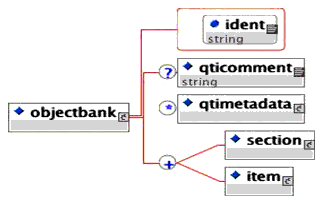 |
1EdTech Question & Test Interoperability: ASI XML Binding Specification Final Specification Version 1.2 |
| Copyright © 2002 1EdTech Consortium, Inc. All Rights Reserved. The 1EdTech Logo is a trademark of 1EdTech Consortium, Inc. Document Name: 1EdTech Question & Test Interoperability: ASI XML Binding Specification Date: 11 February 2002
|
IPR and Distribution Notices
Recipients of this document are requested to submit, with their comments, notification of any relevant patent claims or other intellectual property rights of which they may be aware that might be infringed by any implementation of the specification set forth in this document, and to provide supporting documentation.
1EdTech takes no position regarding the validity or scope of any intellectual property or other rights that might be claimed to pertain to the implementation or use of the technology described in this document or the extent to which any license under such rights might or might not be available; neither does it represent that it has made any effort to identify any such rights. Information on 1EdTech's procedures with respect to rights in 1EdTech specifications can be found at the 1EdTech Intellectual Property Rights web page: http://www.imsglobal.org/ipr/imsipr_policyFinal.pdf.
Copyright © 2002 1EdTech Consortium. All Rights Reserved.
Permission is granted to all parties to use excerpts from this document as needed in producing requests for proposals.
Use of this specification to develop products or services is governed by the license with 1EdTech found on the 1EdTech website: http://www.imsglobal.org/license.html.
The limited permissions granted above are perpetual and will not be revoked by 1EdTech or its successors or assigns.
THIS SPECIFICATION IS BEING OFFERED WITHOUT ANY WARRANTY WHATSOEVER, AND IN PARTICULAR, ANY WARRANTY OF NONINFRINGEMENT IS EXPRESSLY DISCLAIMED. ANY USE OF THIS SPECIFICATION SHALL BE MADE ENTIRELY AT THE IMPLEMENTER'S OWN RISK, AND NEITHER THE CONSORTIUM, NOR ANY OF ITS MEMBERS OR SUBMITTERS, SHALL HAVE ANY LIABILITY WHATSOEVER TO ANY IMPLEMENTER OR THIRD PARTY FOR ANY DAMAGES OF ANY NATURE WHATSOEVER, DIRECTLY OR INDIRECTLY, ARISING FROM THE USE OF THIS SPECIFICATION.
Table of Contents
Table of Contents
1. Introduction
1.1 Question & Test Interoperability Overview
1.2 Scope & Context
1.3 Structure of this Document
1.4 Nomenclature
1.5 References
2. XML Basics
2.1 Elements
2.1.1 Element Contents
2.1.2 Element Attributes
2.1.3 Element Names
2.2 XML Schema
2.3 Document Type Definitions (DTD)
2.3.1 Declaring Element Contents
2.3.2 Declaring Element Attributes
2.3.3 Use of Attributes
2.4 Special Handling Requirements
2.4.1 XML Reserved Characters
2.4.2 White Space Handling
2.5 Extensibility
3. Narrative Description of XML Binding
3.1 <questestinterop> Elements
3.1.1 <qticomment>
3.1.2 <objectbank>
3.1.3 <assessment>
3.1.4 <section>
3.1.5 <item>
3.2 <objectbank> Elements
3.2.1 <qticomment>
3.2.2 <qtimetadata> Element
3.3 <assessment> Elements
3.2.3 <section>
3.2.4 <item>
3.3.1 <qticomment> Element
3.3.2 <duration> Element
3.3.3 <qtimetadata> Element
3.3.4 <objectives> Element
3.3.5 <rubric> Element
3.3.6 <assessmentcontrol> Element
3.3.7 <presentation_material> Element
3.3.8 <outcomes_processing> Element
3.3.9 <assessproc_extension> Element
3.3.10 <assessfeedback> Element
3.3.11 <selection_ordering> Element
3.3.12 <reference> Element
3.3.13 <sectionref> Element
3.3.14 <section> Element
3.4 <section> Elements
3.4.1 <qticomment> Element
3.4.2 <duration> Element
3.4.3 <qtimetadata> Element
3.4.4 <sectionprecondition> Element
3.4.5 <sectionpostcondition> Element
3.4.6 <objectives> Element
3.4.7 <rubric> Element
3.4.8 <sectioncontrol> Element
3.4.9 <presentation_material> Element
3.4.10 <outcomes_processing> Element
3.4.11 <sectionproc_extension> Element
3.4.12 <sectionfeedback> Element
3.4.13 <selection_ordering> Element
3.4.14 <reference> Element
3.4.15 <sectionref> Element
3.4.16 <section> Element
3.4.17 <itemref> Element
3.4.18 <item> Element
3.5 <item> Elements
3.5.1 <qticomment> Element
3.5.2 <duration> Element
3.5.3 <itemmetadata> Element
3.5.4 <itemprecondition> Element
3.5.5 <itempostcondition> Element
3.5.6 <objectives> Element
3.5.7 <itemcontrol> Element
3.5.8 <itemrubric> Element
3.5.9 <rubric> Element
3.5.10 <presentation> Element
3.5.11 <flow> Element
3.5.12 <response_lid> Element
3.5.13 <response_xy> Element
3.5.14 <response_str> Element
3.5.15 <response_num> Element
3.5.16 <response_grp> Element
3.5.17 <render_choice> Element
3.5.18 <render_hotspot> Element
3.5.19 <render_fib> Element
3.5.20 <render_slider> Element
3.5.21 <response_label> Element
3.5.22 <flow_label> Element
3.5.23 <resprocessing> Element
3.5.24 <outcomes> Element
3.5.25 <respcondition> Element
3.5.26 <itemproc_extension> Element
3.5.27 <itemfeedback> Element
3.5.28 <solution> Element
3.5.29 <solutionmaterial> Element
3.5.30 <hint> Element
3.5.31 <hintmaterial> Element
3.6 Common Data Elements
3.6.1 <qticomment> Element
3.6.2 <duration> Element
3.6.3 <material> Element
3.6.4 <altmaterial> Element
3.6.5 <mattext> Element
3.6.6 <matemtext> Element
3.6.7 <matbreak> Element
3.6.8 <matimage> Element
3.6.9 <mataudio> Element
3.6.10 <matvideo> Element
3.6.11 <matapplet> Element
3.6.12 <matapplication> Element
3.6.13 <matref> Element
3.6.14 <mat_extension> Element
3.6.15 <flow_mat> Element
3.6.16 <qtimetadata> Element
3.6.17 <objectives> Element
3.6.18 <rubric> Element
3.6.19 <decvar> Element
3.6.20 <interpretvar> Element
3.6.21 <setvar> Element
3.6.22 <displayfeedback> Element
3.6.23 <conditionvar> Element
3.6.24 <presentation_material> Element
3.6.25 <reference> Element
3.6.26 <material_ref> Element
4. V1.2 Compliant Example XML Instances
4.1 Item XML Instance
4.2 Section XML Instance
4.3 Assessment Schema Instance
About This Document
List of Contributors
Revision History
Index
1. Introduction
1.1 Question & Test Interoperability Overview
The 1EdTech Question & Test Interoperability (QTI) specification describes a basic structure for the representation of question (item) and test (assessment) data and their corresponding results reports [QTI, 02i]. Therefore, the specification enables the exchange of this item, assessment and results data between Learning Management Systems, as well as content authors and, content libraries and collections. The QTI specification is defined in XML to promote the widest possible adoption. XML is a powerful, flexible, industry standard markup language used to encode data models for Internet-enabled and distributed applications. The QTI specification is extensible and customizable to permit immediate adoption, even in specialized or proprietary systems. Leading suppliers and consumers of learning products, services and content contributed time and expertise to produce this final specification. The QTI specification, like all 1EdTech specifications, does not limit product designs by specifying user interfaces, pedagogical paradigms, or establishing technology or policies that constrain innovation, interoperability, or reuse.
This document describes the implementation of the ASI information model in XML. XML is introduced by outlining XML basics, including a conceptual discussion of the XML schema. The XML schema description of the QTI specification (ims_qtiasi_rootv1p1.xsd and ims_qtiasiv1p2.dtd) defines the Assessment, Section, and Item as XML elements. An example schema for Assessments, Sections, and Items is included, along with details of the meta-data used to catalogue Assessment, Sections, and Items1.
1.2 Scope & Context
1.3 Structure of this Document
The structure of this document is:
1.4 Nomenclature
1.5 References
2. XML Basics
The Question & Test Interoperability data model can be defined as a hierarchy. Hierarchical models are convenient for representing data consisting of many elements and sub-elements. XML is perfectly suited for representing hierarchical models. An XML document is a hierarchy comprised of elements that have contents and attributes.
2.1 Elements
An element is a component of a document that has been identified in a way a computer can understand. Each element has a tag name. When a tag name is shown as "<TAGNAME>", with less-than and greater-than symbols before and after the tag name, it serves as the start-tag to mark the beginning of an element. When that same tag name has a forward slash "/" added, it serves as an end-tag such as "</TAGNAME>". An element may have contents between its start and end-tags and may have one or more attributes. When an XML element has a start and end-tag (also called an opening and closing tag) with a common name, it is considered to be "well-formed" XML. The contents of an element are placed between the start and end-tags as shown below:
<TAGNAME>contents</TAGNAME>
2.1.1 Element Contents
An element may contain other elements, Parsed Character Data (PCDATA), Character Data (CDATA), or a mixture of PCDATA and elements. The allowable contents of an element are its content model. PCDATA really means any character string that does not contain elements. PCDATA is what the bulk of elements will use between their start and end-tags. CDATA is different in that it is a method for adding any character data that should not be processed. For example, you could add some Java script code instructions using a CDATA section. A CDATA section tells the parser not to look for any markup until after it locates the end of the CDATA section.
2.1.2 Element Attributes
An attribute provides additional information about an element. Attributes are a way of attaching characteristics or properties to the elements of a document. An element may have more than one attribute and they are contained within the start tag of an element. Attributes are represented by an attribute name followed by an equal sign and the attribute value in quotation marks:
<timeframe>
<begin restrict="1">1999-07-23</begin>
</timeframe>
In this example the <timeframe> element contains another element, the <begin> element. The <begin> element has one attribute "restrict", with the value 1. The value for the element <begin> is "1999-07-23". These two elements then make up a 'timeframe begin' date.
2.1.3 Element Names
Each element has a unique name, referred to as the tag name. XML is case-sensitive in its processing of tag names. The 1EdTech Question & Test Interoperability XML Binding Specification adheres to the following tag name rules:
- All tag names will conform to the rules for element naming as given within the XML Version 1.0 specification;
- Names beginning in "xml" in any case or mix of cases are not permitted;
- All element and attribute names in the 1EdTech XML binding are aligned with the W3C XHTML standard and as such will be lower-case;
- Element names may not include words reserved by the XML specification. These include:
DOCTYPE
ELEMENT
ATTLIST
ENTITY - Tag names defined within the 1EdTech Q&TI XML Binding may not be redefined, with the exception of those that are used for extensions.
2.2 XML Schema
The 1EdTech QTI Results Reporting version 1.2 XML binding is defined in an XML-Schema2. XML-Schema is the primary XML binding control document format of 1EdTech (at present these bindings are working to the May 2001 version of XML Schema). The XML-Schema defines elements, their content models, and attributes. It also defines the standard 1EdTech vocabularies. The XML-Schema defines the element types and attribute groups separately from the elements. This serves three purposes:
- The element names are declared before the type definitions to prevent any declaration confusions by XML-Schema validators. This is analogous to declaring sub-routine and function names separately at the top of a program unit;
- The complexTypes may be managed more effectively, including support for derived types in the near future. Derivation will be used for harmonization and extension;
- The attributes may be managed more effectively, particularly when the same attributes are used by several elements' complexTypes.
|
The XML Schema for the 1EdTech QTI ASI (for version 1.2) is named: |
2.3 Document Type Definitions (DTD)
The tag name, content model, and attributes of elements are defined in a Document Type Definition (DTD) statement. These may exist as an external file or a block of text internal to an XML document. Internal DTDs should be used with care. The DTD defines the elements that may be used, and may define the contents of the elements.
|
This specification defines the external DTD with the file name (for version 1.2): |
Some XML editors may make use of a DTD to help guide the developer in creating the proper elements at the proper locations in an XML file. Other developers will make use of the DTDs to validate their XML documents to ensure their document is consistent with all of the element names and locations defined in the DTD. An XML document is valid if it has an associated document type declaration and if the document complies with the constraints expressed in it. Details of the construction of DTDs are outside the scope of this document, but links to the XML Version 1.0 specification are included in the References section of this document.
2.3.1 Declaring Element Contents
The information specifying the order and usage of allowable contents for an element are its content model. The content model is declared in a DTD (see below). The declaration of the content model is of the general form:
<!ELEMENT tagname (Content Model)>
The SHORT element can again serve as an example of how an element is declared with its content model:
<!ELEMENT short (#PCDATA)>
This element will contain character data (#PCDATA) that can be processed. The XML Specification provides more information about the details for creating and interpreting content models.
2.3.1.1 Lists
A list is a repetition of the contents of an element. In XML, this is accomplished by repeating the containing element: for example, the section element contains an element item. Described in the DTD as:
<!ELEMENT section (item*, extension?)>
When instantiated in XML a repeating list of ITEM elements would appear:
<section>
<item> "The first question set."</item>
<item> "The second question set."</item>
</section>
In this example, the element item is repeated. Thus item is the containing element for the repeated contents descriptions. The notation for repetitions of an element in a content model follows the XML specification. An asterisk (*) specifies that none or more repetitions of the element may be included in the XML instantiation whereas a plus (+) specifies that one or more repetitions of the element may be included in the XML instantiation. The extension element is not used - a question mark (?) specifies that none or one repetitions of the element may be included.
2.3.2 Declaring Element Attributes
An example of how the attributes for the element assessment is declared in a DTD is found below:
<!ELEMENT assessment (description, section+, objectives?, result, extension?)> <!ATTLIST assessment title CDATA #IMPLIED>
The first line declares that there is an element named assessment that must have the description, section and result elements and is additionally allowed to have objectives and/or extension elements as its contents. The second line begins with "!ATTLIST" to start an attribute list declaration for the assessment element. The word title will serve as the attribute's name. The allowable value for this attribute must be of type CDATA.
At the end of the example above is the term IMPLIED. It is at this location in the attribute declaration, where a default value for an attribute may be specified. It is also possible to use the keyword REQUIRED which would force a TYPE value to be supplied and there would be no default value. In the example above, the IMPLIED designation means that the designer wants to allow users to omit the value for the attribute without forcing a particular default value.
2.3.3 Use of Attributes
Within the 1EdTech XML binding, the use of attributes is reserved for information about the structure of the relevant data object. This means that an attribute is used to create a specific type of element e.g. the element could be the date and its attribute could be used to define the date as the date of birth.
2.4 Special Handling Requirements
2.4.1 XML Reserved Characters
Some characters used in XML must be escaped when used outside of their XML defined usage as found in Section 2.4 of the XML 1.0 Specification. These characters are ampersand (&), less than (<), greater than (>), apostrophe(') and the double-quotes character("). These characters may be represented using either numeric character references or the strings ",&", "<", ">", "'", and """. Below is a more complete quote from the W3C XML specification:
Quote from Extensible Markup Language (XML) 1.0
W3C Recommendation 10-February-1998
2.4 Character Data and Markup
Text consists of intermingled character data and markup. Markup takes the form of start-tags, end-tags, empty-element tags, entity references, character references, comments, CDATA section delimiters, document type declarations, and processing instructions.
All text that is not markup constitutes the character data of the document.
The ampersand character (&) and the left angle bracket(<) may appear in their literal form only when used as markup delimiters or within a comment, a processing instruction or a CDATA section. They are also legal within the literal entity value of an internal entity declaration; see "4.3.2 Well-Formed Parsed Entities". If they are needed elsewhere, they must be escaped using either numeric character references or the strings "&" and "<" respectively. The right angle bracket (>) may be represented using the string ">" and must, for compatibility, be escaped using ">" or a character reference when it appears in the string "]]>" in content, when that string is not marking the end of a CDATA section.
In the content of elements, character data is any string of characters which does not contain the start delimiter of any markup. In a CDATA section, character data is any string of characters not including the CDATA-section-close delimiter, "]]>".
To allow attribute values to contain both single and double quotes, the apostrophe or single-quote character (') may be represented as "'", and the double-quote character (") as """.
2.4.2 White Space Handling
Questions arise as to whether web-based data transmission tools might inadvertently strip-off or transform some of the white space characters embedded in the Enterprise data transmitted between systems using XML. To eliminate concern about this issue, refer to the following quote from the W3C XML standards, which indicate that all white space must be preserved where it is part of the data.
Quote from Extensible Markup Language (XML) 1.0
W3C Recommendation 10-February-1998
2.10 White Space Handling
In editing XML documents, it is often convenient to use "white space" (spaces, tabs, and blank lines, denoted by the non-terminal S in this specification) to set apart the markup for greater readability. Such white space is typically not intended for inclusion in the delivered version of the document. On the other hand, "significant" white space that should be preserved in the delivered version is common, for example in poetry and source code.
An XML processor must always pass all characters in a document that are not markup through to the application. A validating XML processor must also inform the application which of these characters constitute white space appearing in element content.
A special attribute named xml:space may be attached to an element to signal an intention that in that element, white space should be preserved by applications. In valid documents, this attribute, like any other, must be declared if it is used. When declared, it must be given as an enumerated type whose only possible values are "default" and "preserve". For example:
<!ATTLIST poem xml:space (default | preserve)'preserve'>
The value "default" signals that applications' default white-space processing modes are acceptable for this element; the value "preserve" indicates the intent that applications preserve all the white space. This declared intent is considered to apply to all elements within the content of the element where it is specified, unless overridden with another instance of the xml:space attribute.
2.5 Extensibility
Some providers will find the current element set defined in the 1EdTech QTI specification too restrictive to accomplish their purposes. To ensure extensibility, the specification requires that there be no limit on potential extensions to major elements. An extension is the addition of information to an existing XML structure.
<!ELEMENT resp_extension ANY>
An example of the inclusion of resp_extension in the content model of element presentation is:
<!ELEMENT presentation (render_choice, render_hotspot, resp_extension?)>
The use of the resp_extension element is illustrated as follows:
<presentation>
<render_choice> ... Multiple choice selections ... </render_choice>
<render_hotspot> ... Image hot spot selections ... </render_hotspot>
<resp_extension>
<comment>This is a test to demo extensions</comment>
</resp_extension>
</presentation>
The contents, but not a content model, of an extension must be declared in an internal or external DTD. Many extensions can be created through the use of existing elements. Care must be used with internal DTDs, as they over-ride external DTD declarations. The content of an extension must obey the attribute and content models of the elements employed. New elements that duplicate the definitions of existing elements should not be introduced.
Prefacing the resp_extension element with an appropriate namespace may reference descriptions of extensions. For example, a group such as the Advanced Distributed Learning (ADL) initiative may wish to add the "adl" prefix to an extension element to uniquely identify ADL extensions (the prefix must be declared in the head of the XML instance). The following is an example of this:
<item>
... mandatory elements of item elements here ...
<description lang= " en " >
<short>Military psychometric question </short>
</description>
<adl:resp_extension adl:classification="Not classified">
<adl:comment>Discusses how the questions are constructed for defence posts.
<adl:comment>
</adl:resp_extension>
</item>
This serves to note the entire extension structure. Extensions should always be added at the lowest point (farthest from the root element) in the hierarchy possible, to the degree that the structure defines the meaning of the extension.
3. Narrative Description of XML Binding
This specification defines the XML format using narrative. XML XSDs and XML DTDs that implement this 'abstract' format are provided as informative parts of this specification.
3.1 <questestinterop> Elements
Description: The <questestinterop> element is the outermost container for the QTI contents i.e. the container of the Assessment(s), Section(s) and Item(s).
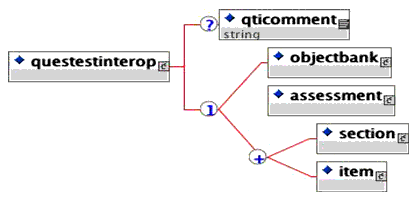
Multiplicity: The <questestinterop> occurs only once in each XML instance file that is used to support Assessment(s), Section(s) and Item(s).
3.1.1 <qticomment>
Description: This element contains the comments that are relevant to the structure as a whole.
Multiplicity: Occurs zero or once within the <questestinterop> element.
Attributes: As per sub-section 3.6.1.
3.1.3 <assessment>
Description: This element contains the Assessment data structure.
Multiplicity: Occurs zero or once within the <questestinterop> element.
Attributes: As per sub-section 3.3.
3.1.4 <section>
Description: This element contains the Section data structure.
Multiplicity: Occurs zero or more times within the <questestinterop> element.
Attributes: As per sub-section 3.4.
3.1.5 <item>
Description: This element contains the Item data structure.
Multiplicity: Occurs zero or more times within the <questestinterop> element.
Attributes: As per sub-section 3.5.
3.3 <assessment> Elements
Description: The Assessment data structure is used to contain the exchange of test data structures. It will always contain at least one Section and may contain meta-data, objectives, rubric control switches, assessment-level processing, feedback and selection and sequencing information for sections.
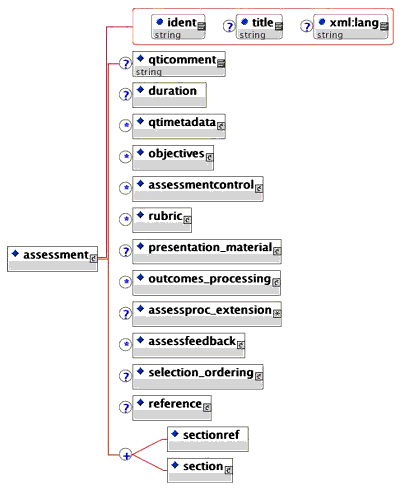
Multiplicity: Occurs zero or once within the <questestinterop> element.
- title (optional). The title of the Item.
Data-type = String (max of 256 chars). - ident (required). The unique identifier for the Item. This identifier should be globally unique (whenever possible this should follow the 1EdTech Persistent Location-Independent Resource Identifier recommendations).
Data-type = String (max of 256 chars).
3.3.1 <qticomment> Element
Description: This element contains the comments that are relevant to the Assessment as a whole.
Multiplicity: Occurs zero or once within the <assessment> element.
Attributes: See sub-section 3.6.1.
3.3.2 <duration> Element
Description: The amount of time that a participant is permitted to use in attempting to complete the Assessment.
Multiplicity: Occurs zero or once within the <assessment> element.
Attributes: See sub-section 3.6.2.
3.3.4 <objectives> Element
Description: The objectives element is used to store the information that describes the educational aims of the Assessment. These objectives can be defined for each of the different 'view' perspectives. This element should not be used to contain information specific to an Assessment because the question-engine may not make this information available to the Item during the actual test.
Multiplicity: Occurs zero or more times within the <assessment> element.
Attributes: See sub-section 3.6.17.
3.3.5 <rubric> Element
Description: The rubric element is used to contain contextual information that is important to the element e.g. it could contain standard data values that might or might not be useful for answering the question. Different sets of rubric can be defined for each of the possible 'views'.
Multiplicity: Occurs zero or more times within the <assessment> element.
Attributes: See sub-section 3.6.18.
3.3.6 <assessmentcontrol> Element
Description: The control switches that are used to enable or disable the display of hints, solutions and feedback within the Assessment.
Multiplicity: Occurs zero or more times within the <assessment> element.

- view (optional with selection from the enumerated list of: All, Administrator, AdminAuthority, Assessor, Author, Candidate, InvigilatorProctor, Psychometrician, Scorer, Tutor. Default=All). The view defines the scope for the display of the associated information i.e. to whom the material can be presented.
Data-type = Enumerated list. - solutionswitch (optional with selection from the enumerated list of: Yes, No. Default=Yes). The switch setting for the display of solutions within the Assessment.
Data-type = Enumerated list. - hintswitch (optional with selection from the enumerated list of: Yes, No. Default=Yes). The switch setting for the display of hints within the Assessment.
Data-type = Enumerated list. - feedbackswitch (optional with selection from the enumerated list of: Yes, No. Default=Yes). The switch setting for the display of feedback within the Assessment.
Data-type = Enumerated list.
3.3.6.1 <qticomment> Element
Description: This element contains the comments that are relevant to the Assessment control switches as a whole.
Multiplicity: Occurs zero or once within the <assessmentcontrol> element.
Attributes: See sub-section 3.6.
3.3.9 <assessproc_extension> Element
Description: This is used to contain proprietary alternative Assessment-level processing functionality.
Multiplicity: Occurs zero or once within the <assessment> element.
3.3.10 <assessfeedback> Element
Description: The container for the Assessment-level feedback that is to be presented as a result of Assessment-level processing of the user's responses.

Multiplicity: Occurs zero or more times within the <assessment> element.
- title (optional). The title of the feedback section.
Data-type = String (max of 256 chars). - ident (required). The unique identifier for the feedback. This identifier is used within the <assessprocessing> element to identify the feedback to be presented as a consequence of the processing of the user's response.
Data-type = String (max of 256 chars). - view (optional with selection from the enumerated list of: All, Administrator, AdminAuthority, Assessor, Author, Candidate, InvigilatorProctor, Psychometrician, Scorer, Tutor. Default=All). The view defines the scope for the display of the associated information i.e. to whom the material can be presented.
Data-type = Enumerated list.
3.3.10.1 <qticomment> Element
Description: This element contains the comments that are relevant to the Assessment feedback as a whole.
Multiplicity: Occurs zero or once within the <assessfeedback> element.
Attributes: See sub-section 3.6.1.
3.3.10.2 <material> Element
Description: This element contains the feedback materials that are to be displayed to the participant.
Multiplicity: Occurs zero or more times within the <assessfeedback> element.
Attributes: See sub-section 3.6.3.
3.3.10.3 <flow_mat> Element
Description: This element contains the feedback materials that are to be displayed to the participant.
Multiplicity: Occurs zero or more times within the <assessfeedback> element.
Attributes: See sub-section 3.6.15.
3.3.13 <sectionref> Element
Description: This element is used to 'pull' a Section into the scope. This is used to refer to a Section that has been defined elsewhere but which is to be logically related to this group of Sections.
Multiplicity: Occurs zero or more times within the <assessment> element.
- linkrefid (required). The identifier of the Section that is being referenced. This material will have been assigned by the ident attribute of the associated <section> element.
Data-type = String (max of 32 chars).
3.3.14 <section> Element
Description: The container for the Section data structure (this is a grouping construct to support the creation of arbitrarily complex hierarchical Assessments).
Multiplicity: Occurs one or more times within the <assessment> element.
Attributes: See sub-section 3.4.
3.4 <section> Elements
Description: The Section data structure is used to define arbitrarily complex hierarchical section and item data structures. It may contain meta-data, objectives, rubric control switches, assessment-level processing, feedback and selection and sequencing information for sections and items.
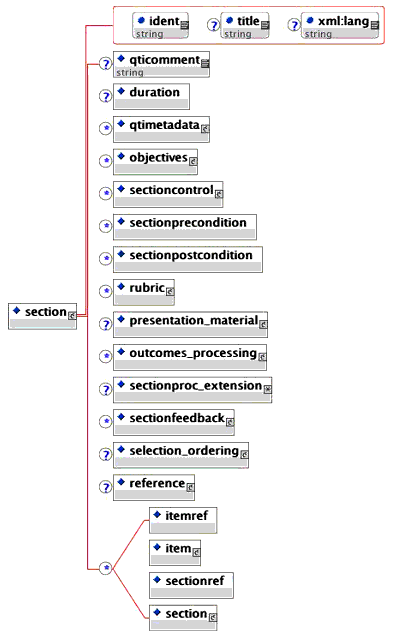
Multiplicity: Occurs once or more times within an <assessment> element, zero or more times in the <questestinterop> element and zero or more times within a <section> element.
- title (optional). The title of the Section.
Data-type = String (max of 256 chars). - ident (required). The unique identifier for the Section. This identifier should be globally unique (whenever possible this should follow the 1EdTech Persistent Location-Independent Resource Identifier recommendations).
Data-type = String (max of 256 chars).
3.4.1 <qticomment> Element
Description: This element contains the comments that are relevant to the Section as a whole.
Multiplicity: Occurs zero or once within the <section> element.
Attributes: As per sub-section 3.6.1
3.4.2 <duration> Element
Description: The amount of time that a participant is permitted to use in attempting to complete the Section.
Multiplicity: Occurs zero or once within the <section> element.
Attributes: See sub-section 3.6.2.
3.4.4 <sectionprecondition> Element
Description: The preconditions that control whether or not the Section is activated.
This is for further study in V2.0.
Multiplicity: Occurs zero or more times within the <section> element.
3.4.5 <sectionpostcondition> Element
Description: The postconditions that control whether or not the next Section may be activated.
This is for further study in V2.0.
Multiplicity: Occurs zero or more times within the <section> element.
3.4.6 <objectives> Element
Description: The objectives element is used to store the information that describes the educational aims of the Section. These objectives can be defined for each of the different 'view' perspectives. This element should not be used to contain information specific to the Items in a Section because the question-engine may not make this information available to the Items during the actual test.
Multiplicity: Occurs zero or more times within the <section> element.
Attributes: See sub-section 3.6.17.
3.4.7 <rubric> Element
Description: The rubric element is used to contain contextual information that is important to the element e.g. it could contain standard data values that might or might not be useful for answering the question. Different sets of rubric can be defined for each of the possible 'views'.
Multiplicity: Occurs zero or more times within the <section> element.
Attributes: See sub-section 3.6.18.
3.4.8 <sectioncontrol> Element
Description: The control switches that are used to enable or disable the display of hints, solutions and feedback within the Section.

Multiplicity: Occurs zero or more times within the <section> element.
- view (optional with selection from the enumerated list of: All, Administrator, AdminAuthority, Assessor, Author, Candidate, InvigilatorProctor, Psychometrician, Scorer, Tutor. Default=All). The view defines the scope for the display of the associated information i.e. to whom the material can be presented.
Data-type = Enumerated list. - solutionswitch (optional with selection from the enumerated list of: Yes, No. Default=Yes). The switch setting for the display of solutions within the Section.
Data-type = Enumerated list. - hintswitch (optional with selection from the enumerated list of: Yes, No. Default=Yes). The switch setting for the display of hints within the Section.
Data-type = Enumerated list. - feedbackswitch (optional with selection from the enumerated list of: Yes, No. Default=Yes). The switch setting for the display of feedback within the Section.
Data-type = Enumerated list.
3.4.11 <sectionproc_extension> Element
Description: This is used to contain proprietary alternative Section-level processing functionality.
Multiplicity: Occurs zero or once within the <section> element.
3.4.12 <sectionfeedback> Element
Description: The container for the Section-level feedback that is to be presented as a result of Section-level processing of the user's responses.

Multiplicity: Occurs zero or more times within the <section> element.
- title (optional). The title of the feedback section.
Data-type = String (max of 256 chars). - ident (required). The unique identifier for the feedback. This identifier is used within the <sectionprocessing> element to identify the feedback to be presented as a consequence of the processing of the user's response.
Data-type = String (max of 256 chars). - view (optional with selection from the enumerated list of: All, Administrator, AdminAuthority, Assessor, Author, Candidate, InvigilatorProctor, Psychometrician, Scorer, Tutor. Default=All). The view defines the scope for the display of the associated information i.e. to whom the material can be presented.
Data-type = Enumerated list.
3.4.12.1 <qticomment> Element
Description: This element contains the comments that are relevant to the Section feedback as a whole.
Multiplicity: Occurs zero or once within the <sectionfeedback> element.
Attributes: As per sub-section 3.6.1.
3.4.12.2 <material> Element
Description: This element contains the feedback materials that are to be displayed to the participant.
Multiplicity: Occurs zero or more times within the <sectionfeedback> element.
Attributes: See sub-section 3.6.3.
3.4.12.3 <flow_mat> Element
Description: This element contains the block/paragraph structured feedback materials that are to be displayed to the participant.
Multiplicity: Occurs zero or more times within the <sectionfeedback> element.
Attributes: See sub-section 3.6.15.
3.4.15 <sectionref> Element
Description: This element is used to 'pull' a Section into the scope. This is used to refer to a Section that has been defined elsewhere but which is to be logically related to this group of Sections.
Multiplicity: Occurs zero or more times within the <section> element.
- linkrefid (required). The identifier of the Section that is being referenced. This material will have been assigned by the ident attribute of the associated <section> element.
Data-type = String (max of 32 chars).
3.4.16 <section> Element
Description: The container for the Section data structure (this is a grouping construct to support the creation of arbitrarily complex hierarchical Assessments).
Multiplicity: Occurs one or more times within the <section> element.
Attributes: See sub-section 3.4.
3.4.17 <itemref> Element
Description: This element is used to 'pull' an Item into the scope. This is used to refer to a Item that has been defined elsewhere but which is to be logically related to this group of Items.
Multiplicity: Occurs zero or more times within the <section> element.
- linkrefid (required). The identifier of the Item that is being referenced. This material will have been assigned by the ident attribute of the associated <item> element.
Data-type = String (max of 256 chars).
3.4.18 <item> Element
Description: The Item is the smallest unit data structure that can be exchanged using the QTI specification. Each Item consists of five distinct parts, namely: objectives - the materials used to describe the objectives with respect to each view; rubric - the materials used to define the context of the Item and available for each view; presentation - the instructions describing the nature of the question to be asked; resprocessing - the instructions to be followed when analyzing the responses to create a corresponding score and feedback; itemfeedback - the materials to be presented as feedback to the entered response.
Multiplicity: Occurs zero or more times within the <section> element.
Attributes: See sub-section 3.5.
3.5 <item> Elements
Description: Each Item consists of five distinct parts, namely: objectives - the materials used to describe the objectives with respect to each view; rubric - the materials used to define the context of the Item and available for each view; presentation - the instructions describing the nature of the question to be asked; resprocessing - the instructions to be followed when analyzing the responses to create a corresponding score and feedback; itemfeedback - the materials to be presented as feedback to the entered response.
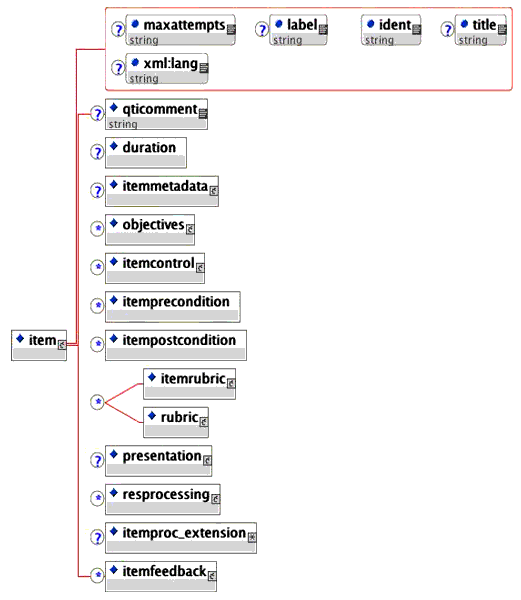
Multiplicity: Occurs one or more times within the <questestinterop> element.
- title (optional). The title of the Item.
Data-type = String (max of 256 chars). - label (optional). A label that can be used by authoring tools to identify key features.
Data-type = String (max of 256 chars). - ident (required). The unique identifier for the Item. This identifier should be globally unique (a possible naming convention is included later in this specification).
Data-type = String (max of 256 chars). - maxattempts (optional). The number of attempts permitted for each participant.
Data-type = String (max of 2 chars).
- qticomment
- duration
- itemmetadata
- objectives
- itemcontrol
- itemprecondition
- itempostcondition
- itemrubric
- rubric
- presentation
- resprocessing
- itemproc_extension
- itemfeedback
3.5.1 <qticomment> Element
Description: This element contains the comments that are relevant to the Item as a whole.
Multiplicity: Occurs zero or once within the <item> element.
Attributes: See sub-section 3.6.1.
3.5.2 <duration> Element
Description: The amount of time that a participant is permitted to use in attempting to complete the Item.
Multiplicity: Occurs zero or once within the <item> element.
Attributes: See sub-section 3.6.2.
3.5.3 <itemmetadata> Element
Description: The itemmetadata element contains all of the QTI-specific meta-data to be applied to the Item. This meta-data can consist of either entries defined using an external vocabulary or the individually named entries.
Multiplicity: Occurs zero or once within the <item> element.
- qtimetadata
- qmd_computerscored
- qmd_feedbackpermitted
- qmd_hintspermitted
- qmd_itemtype
- qmd_levelofdifficulty
- qmd_maximumscore
- qmd_renderingtype
- qmd_responsetype
- qmd_scoringpermitted
- qmd_solutionspermitted
- qmd_status
- qmd_timedependence
- qmd_timelimit
- qmd_toolvendor
- qmd_topic
- qmd_weighting
- qmd_material
- qmd_typeofsolution
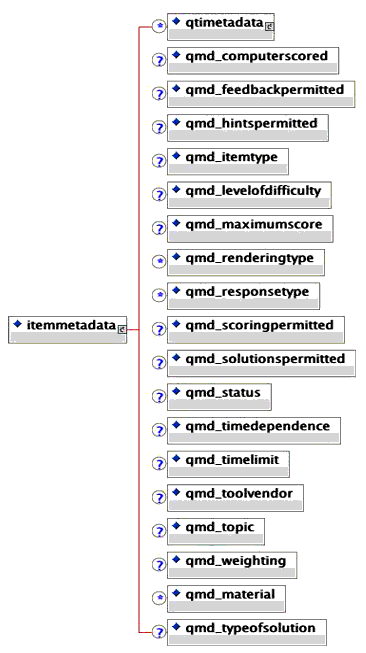
3.5.3.1 <qtimetadata> Element
Description: The container for the definition of QTI-specific meta-data entries that are defined using an external vocabulary.
Multiplicity: Occurs zero or more times within the <item> element.
Attributes: As per sub-section 3.6.16.
3.5.3.2 <qmd_computerscored> Element
Description: Whether or not the Item can be computer scored.
This element is deprecated and the <qtimetadata> mechanism should be used instead.
Multiplicity: Occurs zero or once within the <itemmetadata> element.
3.5.3.3 <qmd_feedbackpermitted> Element
Description: Indicates whether or not feedback is available within the Item.
This element is deprecated and the <qtimetadata> mechanism should be used instead.
Multiplicity: Occurs zero or once within the <itemmetadata> element.
3.5.3.4 <qmd_hintspermitted> Element
Description: Indicates whether or not hints are available within the Item.
This element is deprecated and the <qtimetadata> mechanism should be used instead.
Multiplicity: Occurs zero or once within the <itemmetadata> element.
3.5.3.5 <qmd_itemtype> Element
Description: The type of Item available.
Multiplicity: Occurs zero or once within the <itemmetadata> element.
This element is deprecated and the <qtimetadata> mechanism should be used instead.
3.5.3.6 <qmd_levelofdifficulty> Element
Description: The educational level for which the Item is intended.
This element is deprecated and the <qtimetadata> mechanism should be used instead.
Multiplicity: Occurs zero or once within the <itemmetadata> element.
3.5.3.7 <qmd_material> Element
Description: The type of material content used within the Item.
Multiplicity: Occurs zero or more times within the <itemmetadata> element.
This element is deprecated and the <qtimetadata> mechanism should be used instead.
3.5.3.8 <qmd_maximumscore> Element
Description: The maximum score possible from the Item.
This element is deprecated and the <qtimetadata> mechanism should be used instead.
Multiplicity: Occurs zero or once within the <itemmetadata> element.
3.5.3.9 <qmd_renderingtype> Element
Description: The type of rendering used within the Item.
This element is deprecated and the <qtimetadata> mechanism should be used instead.
Multiplicity: Occurs zero or more times within the <itemmetadata> element.
3.5.3.10 <qmd_responsetype> Element
Description: The class of response expected for the Item.
Multiplicity: Occurs zero or more times within the <itemmetadata> element.
This element is deprecated and the <qtimetadata> mechanism should be used instead.
3.5.3.11 <qmd_scoringpermitted> Element
Description: Indicates whether or not scoring is available within the Item.
This element is deprecated and the <qtimetadata> mechanism should be used instead.
Multiplicity: Occurs zero or once within the <itemmetadata> element.
3.5.3.12 <qmd_solutionspermitted> Element
Description: Indicates whether or not solutions are available within the Item.
This element is deprecated and the <qtimetadata> mechanism should be used instead.
Multiplicity: Occurs zero or once within the <itemmetadata> element.
3.5.3.13 <qmd_status> Element
Description: The status of the Item.
Multiplicity: Occurs zero or once within the <itemmetadata> element.
This element is deprecated and the <qtimetadata> mechanism should be used instead.
3.5.3.14 <qmd_timedependence> Element
Description: Whether or not the responses are time dependent.
This element is deprecated and the <qtimetadata> mechanism should be used instead.
Multiplicity: Occurs zero or once within the <itemmetadata> element.
3.5.3.15 <qmd_timelimit> Element
Description: The number of minutes to be permitted for the completion of the Item.
This element is deprecated and the <qtimetadata> mechanism should be used instead.
Multiplicity: Occurs zero or once within the <itemmetadata> element.
3.5.3.16 <qmd_toolvendor> Element
Description: The name of the vendor of the tool creating the Item.
This element is deprecated and the <qtimetadata> mechanism should be used instead.
Multiplicity: Occurs zero or once within the <itemmetadata> element.
3.5.3.17 <qmd_topic> Element
Description: The brief description of the topic covered by the Item.
This element is deprecated and the <qtimetadata> mechanism should be used instead.
Multiplicity: Occurs zero or once within the <itemmetadata> element.
3.5.3.18 <qmd_typeofsolution> Element
Description: The type of solution available in the Item.
This element is deprecated and the <qtimetadata> mechanism should be used instead.
Multiplicity: Occurs zero or once within the <itemmetadata> element.
3.5.3.19 <qmd_weighting> Element
Description: The weighting to be applied to the scores allocated to this Item before aggregations with other scores.
This element is deprecated and the <qtimetadata> mechanism should be used instead.
Multiplicity: Occurs zero or once within the <itemmetadata> element.
3.5.4 <itemprecondition> Element
Description: The preconditions that control whether or not the Item is activated.
This is for further study in V2.0.
Multiplicity: Occurs zero or more times within the <item> element.
3.5.5 <itempostcondition> Element
Description: The postconditions that control whether or not the next Item may be activated.
This is for further study in V2.0.
Multiplicity: Occurs zero or more times within the <item> element.
3.5.6 <objectives> Element
Description: The objectives element is used to store the information that describes the educational aims of the Item. These objectives can be defined for each of the different 'view' perspectives. This element should not be used to contain information specific to an Item because the question-engine may not make this information available to the Item during the actual test.
Multiplicity: Occurs zero or more times within the <item> element.
Attributes: See sub-section 3.6.17.
3.5.7 <itemcontrol> Element
Description: The control switches that are used to enable or disable the display of hints, solutions and feedback within the Item.
Multiplicity: Occurs zero or more times within the <item> element.
- view (optional with selection from the enumerated list of: All, Administrator, AdminAuthority, Assessor, Author, Candidate, InvigilatorProctor, Psychometrician, Scorer, Tutor. Default=All). The view defines the scope for the display of the associated information i.e. to whom the material can be presented.
Data-type = Enumerated list. - solutionswitch (optional with selection from the enumerated list of: Yes, No. Default=Yes). The switch setting for the display of solutions within the Item.
Data-type = Enumerated list. - hintswitch (optional with selection from the enumerated list of: Yes, No. Default=Yes). The switch setting for the display of hints within the Item.
Data-type = Enumerated list. - feedbackswitch (optional with selection from the enumerated list of: Yes, No. Default=Yes). The switch setting for the display of feedback within the Item.
Data-type = Enumerated list.

3.5.7.1 <qticomment > Element
Description: This element contains the comments that are relevant to the Item control switches as a whole.
Multiplicity: Occurs zero or once within the <itemcontrol> element.
Attributes: As per sub-section 3.6.1
3.5.8 <itemrubric> Element
Description: The itemrubric element is used to contain contextual information that is important to the element e.g. it could contain standard data values that might or might not be useful for answering the question. Different sets of rubric can be defined for each of the possible 'views'. This approach is deprecated in favour of the <rubric> element.

Multiplicity: Occurs zero or more times within the <item> element.
- view (optional with selection from the enumerated list of: All, Administrator, AdminAuthority, Assessor, Author, Candidate, InvigilatorProctor, Psychometrician, Scorer, Tutor. Default=All). The view defines the scope for the display of the associated information i.e. to whom the material can be presented.
Data-type = Enumerated list.
3.5.9 <rubric> Element
Description: The rubric element is used to contain contextual information that is important to the element e.g. it could contain standard data values that might or might not be useful for answering the question. Different sets of rubric can be defined for each of the possible 'views'.
Multiplicity: Occurs zero or more times within the <item> element.
Attributes: See sub-section 3.6.18.
3.5.10 <presentation> Element
Description: This element contains all of the instructions for the presentation of the question during an evaluation. This information includes the actual material to be presented. The labels for the possible responses are also identified and these are used by the response processing element defined elsewhere in the Item.
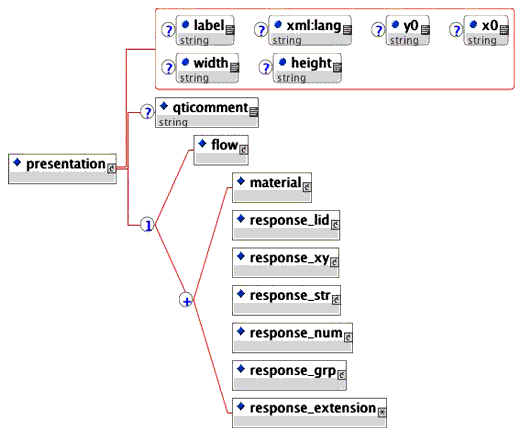
Multiplicity: Occurs zero or once within the <item> element.
- label (optional). A label that can be used by authoring tools to identify key features.
Data-type = String (max of 256 chars).
- qticomment
- flow
- material
- response_lid
- response_xy
- response_str
- response_num
- response_grp
- response_extension
3.5.10.1 <qticomment> Element
Description: This element contains the comments that are relevant to the presentation of the Item.
Multiplicity: Occurs zero or once within the <presentation> element.
Attributes: See sub-section 3.6.1.
3.5.10.2 <material> Element
Description: This element contains the presentation materials that are to be displayed to the participant as part of the question.
Multiplicity: Occurs zero or more times within the <presentation> element.
Attributes: See sub-section 3.6.3.
3.5.10.3 <response_extension> Element
Description: This element supports proprietary alternatives to the current range of 'response' elements.
Multiplicity: Occurs zero or once within the <presentation> element.
3.5.11 <flow> Element
Description: This element contains all of the instructions for the presentation with flow blocking of the question during a test. This information includes the actual material to be presented. The labels for the possible responses are also identified and these are used by the response processing element defined elsewhere in the Item.
Multiplicity: Occurs zero or once within the <presentation> element.
- class (optional. Default=Block). The type of flow blocking to be applied to the contained material.
Data-type = String (max of 32 chars).
- flow
- material
- material_ref
- response_lid
- response_xy
- response_str
- response_num
- response_grp
- response_extension
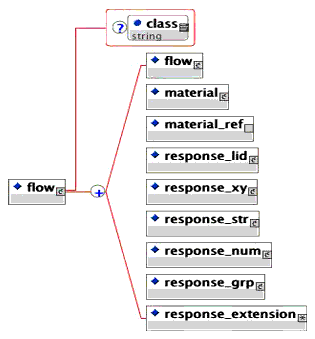
3.5.11.1 <qticomment> Element
Description: This element contains the comments that are relevant to the presentation of the Item.
Multiplicity: Occurs zero or once within the <flow> element.
Attributes: See sub-section 3.6.1.
3.5.11.2 <material> Element
Description: This element contains the presentation materials that are to be displayed to the participant as part of the question.
Multiplicity: Occurs zero or more times within the <flow> element.
Attributes: See sub-section 3.6.3.
3.5.11.4 <response_extension> Element
Description: This element supports proprietary alternatives to the current range of 'response' elements.
Multiplicity: Occurs zero or once within the <flow> element.
3.5.12 <response_lid> Element
Description: The <response_lid> element contains the instructions for the presentation of questions whose response will be the logical label of the selected answer. The question can be rendered in a variety of ways depending on the way in which the material is to be presented to the participant.
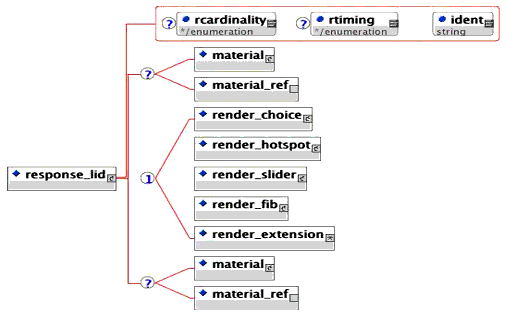
Multiplicity: Occurs zero or more times within the <presentation> element.
- ident (required). The unique identifier for the response presentation block. This identifier will be used within the response processing structure to ensure the right set of response labels are processed.
Data-type = String (max of 256 chars). - rcardinality (optional - enumerated list: Single, Multiple, Ordered. Default=Single). Indicates the number of responses expected from the user.
Data-type = Enumerated list. - rtiming (optional - enumerated list: No, Yes. Default=No). Indicates whether or not the responses are time dependent.
Data-type = Enumerated list.
3.5.12.1 <material> Element
Description: This element contains the presentation materials that are to be displayed to the participant as part of the question.
Multiplicity: Occurs zero or more times within the <response_lid> element.
Attributes: See sub-section 3.6.3.
3.5.12.3 <render_extension> Element
Description: This element supports proprietary alternatives to the current range of 'render' elements.
Multiplicity: Occurs zero or once within the <response_lid> element.
3.5.13 <response_xy> Element
Description: The <response_xy> element contains the instructions for the presentation of questions whose response will be the 'x-y' co-ordinate of the selected answer. The question can be rendered in a variety of ways depending on the way in which the material is to be presented to the participant.
Multiplicity: Occurs zero or more times within the <presentation> element.
- ident (required). The unique identifier for the response presentation block. This identifier will be used within the response processing structure to ensure the right set of response labels are processed.
Data-type = String (max of 256 chars). - rcardinality (optional - enumerated list: Single, Multiple, Ordered. Default=Single). Indicates the number of responses expected from the user.
Data-type = Enumerated list. - rtiming (optional - enumerated list: No, Yes. Default=No). Indicates whether or not the responses are time dependent.
Data-type = Enumerated list.
3.5.13.1 <material> Element
Description: This element contains the presentation materials that are to be displayed to the participant as part of the question.
Multiplicity: Occurs zero or more times within the <response_xy> element.
Attributes: See sub-section 3.6.3.
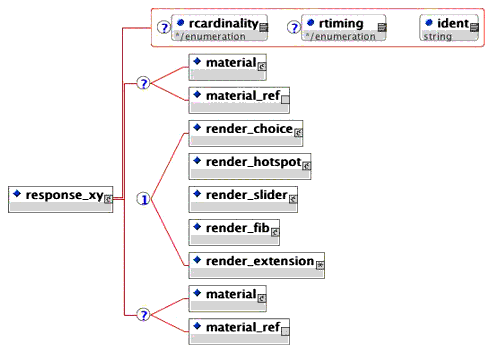
3.5.13.3 <render_extension> Element
Description: This element supports proprietary alternatives to the current range of 'render' elements.
Multiplicity: Occurs zero or once within the <response_xy> element.
3.5.14 <response_str> Element
Description: The <response_str> element contains the instructions for the presentation of questions whose response will be the a string. The question can be rendered in a variety of ways depending on the way in which the material is to be presented to the participant.
Multiplicity: Occurs zero or more times within the <presentation> element.
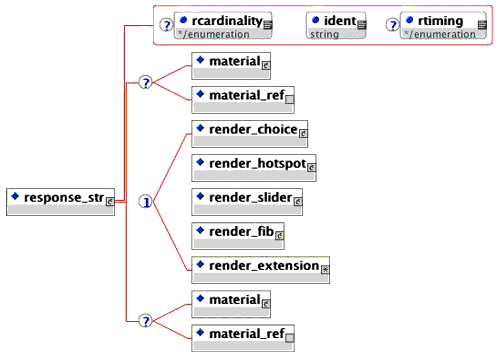
- ident (required). The unique identifier for the response presentation block. This identifier will be used within the response processing structure to ensure the right set of response labels are processed.
Data-type = String (max of 256 chars). - rcardinality (optional - enumerated list: Single, Multiple, Ordered. Default=Single). Indicates the number of responses expected from the user.
Data-type = Enumerated list. - rtiming (optional - enumerated list: No, Yes. Default=No). Indicates whether or not the responses are time dependent.
Data-type = Enumerated list.
3.5.14.1 <material> Element
Description: This element contains the presentation materials that are to be displayed to the participant as part of the question.
Multiplicity: Occurs zero or more times within the <response_str> element.
Attributes: See sub-section 3.6.3.
3.5.14.3 <render_extension> Element
Description: This element supports proprietary alternatives to the current range of 'render' elements.
Multiplicity: Occurs zero or once within the <response_str> element.
3.5.15 <response_num> Element
Description: The <response_num> element contains the instructions for the presentation of questions whose response will be a number. The question can be rendered in a variety of ways depending on the way in which the material is to be presented to the participant.
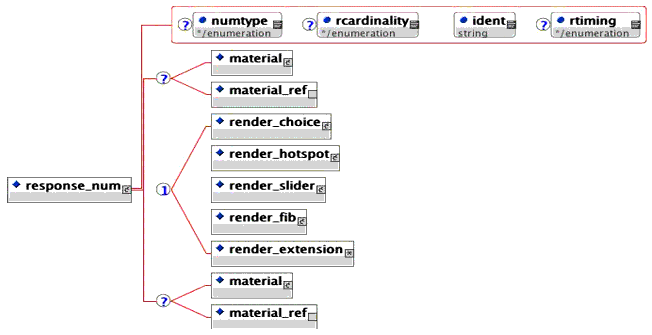
Multiplicity: Occurs zero or more times within the <presentation> element.
- ident (required). The unique identifier for the response presentation block. This identifier will be used within the response processing structure to ensure the right set of response labels are processed.
Data-type = String (max of 256 chars). - rcardinality (optional - enumerated list: Single, Multiple, Ordered. Default=Single). Indicates the number of responses expected from the user.
Data-type = Enumerated list. - rtiming (optional - enumerated list: No, Yes. Default=No). Indicates whether or not the responses are time dependent.
Data-type = Enumerated list. - numtype (optional - enumerated list: Integer, Decimal, Scientific. Default=Integer). Indicates the type of numeric input expected as a response.
Data-type = Enumerated list.
3.5.15.1 <material> Element
Description: This element contains the presentation materials that are to be displayed to the participant as part of the question.
Multiplicity: Occurs zero or more times within the <response_num> element.
Attributes: See sub-section 3.6.3.
3.5.15.3 <render_extension> Element
Description: This element supports proprietary alternatives to the current range of 'render' elements.
Multiplicity: Occurs zero or once within the <response_num> element.
3.5.16 <response_grp> Element
Description: The <response_grp> element contains the instructions for the presentation of questions whose response will be a group of logical identifiers. The question can be rendered in a variety of ways depending on the way in which the material is to be presented to the participant.
Multiplicity: Occurs zero or more times within the <presentation> element.
- ident (required). The unique identifier for the response presentation block. This identifier will be used within the response processing structure to ensure the right set of response labels are processed.
Data-type = String (max of 256 chars). - rcardinality (optional - enumerated list: Single, Multiple, Ordered. Default=Single). Indicates the number of responses expected from the user.
Data-type = Enumerated list. - rtiming (optional - enumerated list: No, Yes. Default=No). Indicates whether or not the responses are time dependent.
Data-type = Enumerated list.
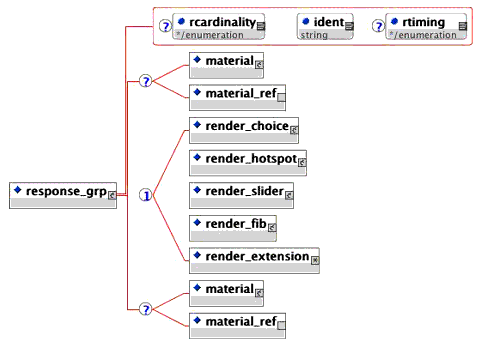
3.5.16.1 <material> Element
Description: This element contains the presentation materials that are to be displayed to the participant as part of the question.
Multiplicity: Occurs zero or more times within the <response_grp> element.
Attributes: See sub-section 3.6.3.
3.5.16.3 <render_extension> Element
Description: This element supports proprietary alternatives to the current range of 'render' elements.
Multiplicity: Occurs zero or once within the <response_grp> element.
3.5.17 <render_choice> Element
Description: The <render_choice> element instructs the question-engine to render the question using a classical multiple-choice format. The number of possible responses is determined by the <response_label> elements contained. Both flowed and non-flowed formats are supported.
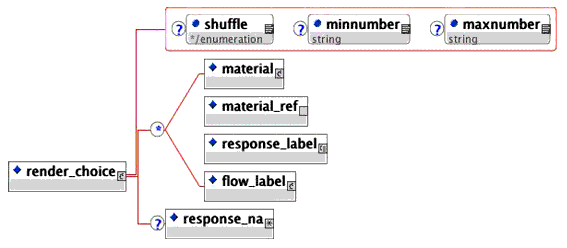
Multiplicity: Occurs zero or once within the <response_lid>, <response_xy>, <response_str>, <response_num> and <response_grp> elements.
- shuffle (optional - enumerated list of: Yes, No. Default = No). Shows whether or not the list of possible responses can be shuffled between consecutive displays to the user.
Data-type = Enumerated list. - minnumber (optional). The minimum number of responses that must be supplied by the participant.
Data-type = String (2 chars to represent the integer value 0-99). - maxnumber (optional). The maximum number of responses that can be supplied by the participant.
Data-type = String (2 chars to represent the integer value 1-99).
3.5.17.1 <material> Element
Description: This element contains the presentation materials that are to be displayed to the participant as part of the question.
Multiplicity: Occurs zero or more times within the <render_choice> element.
Attributes: See sub-section 3.6.3.
3.5.17.3 <response_na> Element
Description: This element supports proprietary alternatives for defining the response to be created when a participant makes no response to an Item.
Multiplicity: Occurs zero or once within the <render_choice> element.
3.5.18 <render_hotspot> Element
Description: The <render_hotspot> element instructs the question-engine to render the question using a classical image hot-spot format. The number of possible responses is determined by the <response_label> elements contained. Both flowed and non-flowed formats are supported.

Multiplicity: Occurs zero or once within the <response_lid>, <response_xy>, <response_str>, <response_num> and <response_grp> elements.
- showdraw (optional - enumerated list of: Yes, No. Default = No). Informs the rendering system that the points identified by participants are to be displayed as connected points using an appropriate graphic.
Data-type = Enumerated list. - minnumber (optional). The minimum number of responses that must be supplied by the participant.
Data-type = String (2 chars to represent the integer value 0-99). - maxnumber (optional). The maximum number of responses that can be supplied by the participant.
Data-type = String (2 chars to represent the integer value 1-99).
3.5.18.1 <material> Element
Description: This element contains the presentation materials that are to be displayed to the participant as part of the question.
Multiplicity: Occurs zero or more times within the <render_hotspot> element.
Attributes: See sub-section 3.6.3.
3.5.18.3 <response_na> Element
Description: This element supports proprietary alternatives for defining the response to be created when a participant makes no response to an Item.
Multiplicity: Occurs zero or once within the <render_hotspot> element.
3.5.19 <render_fib> Element
Description: The <render_fib> element instructs the question-engine to render the question using a classical fill-in-blank format. The number of possible responses is determined by the <response_label> elements contained. Both flowed and non-flowed formats are supported.
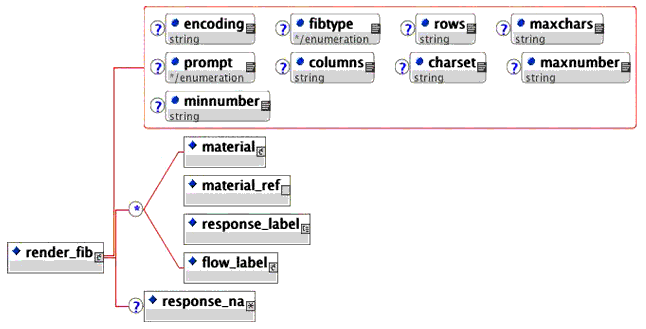
Multiplicity: Occurs zero or once within the <response_lid>, <response_xy>, <response_str>, <response_num> and <response_grp> elements.
- charset (optional. Default='ascii-us'). The character set that is to be used to represent the text string.
Data-type = String (max of 32 chars). - encoding (optional. Default='UTF-8'). The coding to be used for the text.
Data-type = String (max of 32 chars). - rows (optional). The number of rows available for the data entry.
Data-type = String (3 chars to represent the integer value 1-999). - columns (optional). The number of columns available for the data entry.
Data-type = String (3 chars to represent the integer value 1-999). - maxchars (optional). The maximum number of characters available for the data entry.
Data-type = String (8 chars to represent the integer value 1-99999999). - prompt (optional - enumerated list of: Box, Dashline, Asterisk, Underline. Default = Box). The type of prompt presented to the participant in which the FIB data is to be entered.
Data-type = Enumerated list. - fibtype (optional - enumerated list of: String, Integer, Decimal, Scientific, Boolean. Default = String). The type of data expected.
Data-type = Enumerated list. - minnumber (optional). The minimum number of responses that must be supplied by the participant.
Data-type = String (2 chars to represent the integer value 0-99). - maxnumber (optional). The maximum number of responses that can be supplied by the participant.
Data-type = String (2 chars to represent the integer value 1-99).
3.5.19.1 <material> Element
Description: This element contains the presentation materials that are to be displayed to the participant as part of the question.
Multiplicity: Occurs zero or more times within the <render_fib> element.
Attributes: See sub-section 3.6.3.
3.5.19.3 <response_na> Element
Description: This element supports proprietary alternatives for defining the response to be created when a participant makes no response to an Item.
Multiplicity: Occurs zero or once within the <render_fib> element.
3.5.20 <render_slider> Element
Description: The <render_slider> element instructs the question-engine to render the question using dynamic slider. The number of possible responses is determined by the <response_label> elements contained. Both flowed and non-flowed formats are supported.
Multiplicity: Occurs zero or once within the <response_lid>, <response_xy>, <response_str>, <response_num> and <response_grp> elements.
- orientation (optional - enumerated list of: Horizontal, Vertical. Default = Box). The orientation of the slider.
Data-type = Enumerated list. - lowerbound (required). The lowest value shown on the slider.
Data-type = String (16 chars to represent the corresponding numerical value). - upperbound (required). The highest value shown on the slider.
Data-type = String (16 chars to represent the corresponding numerical value). - step (optional). The increment value of the slider.
Data-type = String (16 chars to represent the corresponding numerical value). - startval (optional). The setting at which the slider is set when displayed.
Data-type = String (16 chars to represent the corresponding numerical value). - steplabel (optional - enumerated list of: Yes, No. Default = Yes). Defines if the units labels are to be displayed or not.
Data-type = Enumerated list. - minnumber (optional). The minimum number of responses that must be supplied by the participant.
Data-type = String (2 chars to represent the integer value 0-99). - maxnumber (optional). The maximum number of responses that can be supplied by the participant.
Data-type = String (2 chars to represent the integer value 1-99).
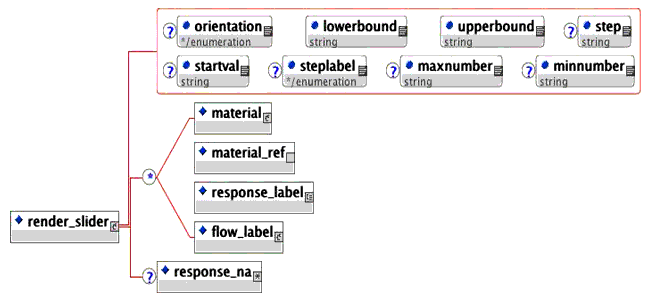
3.5.20.1 <material> Element
Description: This element contains the presentation materials that are to be displayed to the participant as part of the question.
Multiplicity: Occurs zero or more times within the <render_slider> element.
Attributes: See sub-section 3.6.3.
3.5.20.3 <response_na> Element
Description: This element supports proprietary alternatives for defining the response to be created when a participant makes no response to an Item.
Multiplicity: Occurs zero or once within the <render_slider> element.
3.5.21 <response_label> Element
Description: The <response_label> is used to define the possible response choices that are presented to the user. This information includes the material to be shown to the user and the logical label that is associated with that response. The label is used in the response processing. Flow and non-flow approaches are supported.
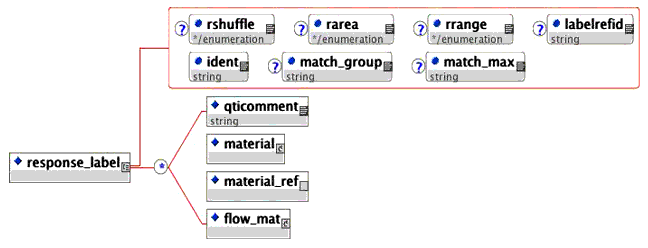
Multiplicity: This occurs zero or more times within the <render_choice>, <render_hotspot>, <render_fib> and <render_slider> elements.
3.5.22 <flow_label> Element
Description: The <flow_label> element is the blocking/paragraph equivalent to the <response_label> element.
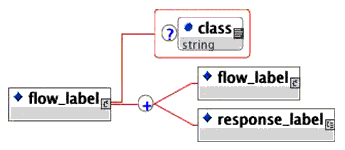
Multiplicity: Occurs zero or more times within the <response_lid>, <response_xy>, <response_str>, <response_num> and <response_grp> elements.
3.5.23 <resprocessing> Element
Description: This is the element within which all of the instructions for the response processing are contained. This includes the scoring variables to contain the associated scores and the set of response condition tests that are to be applied to the received user response.
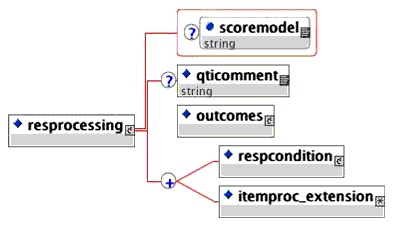
3.5.24 <outcomes> Element
Description: The <outcomes> element contains all of the variable declarations that are to be made available to the scoring algorithm. Each variable is declared using the <decvar> element apart from the default variable called 'SCORE' that is an integer and has a default value of zero (0).
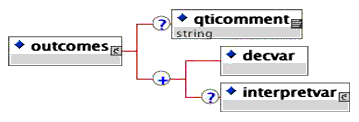
Multiplicity: This occurs once within the <resprocessing> element.
3.5.24.1 <qticomment> Element
Description: This element contains the comments that are relevant to the presentation of the Item.
Multiplicity: Occurs zero or once within the <outcomes> element.
Attributes: See sub-section 3.6.1.
3.5.24.2 <decvar> Element
Description: The <decvar> element permits the declaration of the scoring variables.
Multiplicity: This occurs one or more times within the <outcomes> element.
Attributes: See sub-section 3.6.19.
3.5.24.3 <interpretvar> Element
Description: The <interpretvar> element is used to provide statistical interpretation information about the associated variables.
Multiplicity: This occurs zero or more times within the <outcomes> element.
Attributes: See sub-section 3.6.20.
3.5.25 <respcondition> Element
Description: This element contains the actual test to be applied to the user responses to determine their correctness or otherwise. Each <respcondition> contains an actual test, the assignment of a value to the associate scoring variables and the identification of the feedback to be associated with the test.
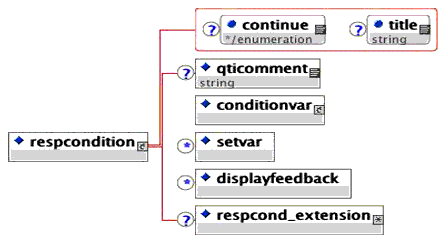
Multiplicity: This occurs one or more times within the <resprocessing> element.
- title (optional). The title of the response condition test e.g. 'correct response test', etc.
Data-type = String (max of 256 chars). - continue (optional - enumerated list: Yes, No. Default=No). This is a switch to indicate if further response condition tests are to be applied. The state of this switch is only valid if the application of the previous condition resulted in 'True'.
Data-type = Enumerated list.
3.5.25.1 <qticomment> Element
Description: This element contains the comments that are relevant to the presentation of the Item.
Multiplicity: Occurs zero or once within the <respcondition> element.
Attributes: See sub-section 3.6.1.
3.5.25.2 <conditionvar> Elements
Description: The conditional test that is to be applied to the user's response. A wide range of separate and combinatorial tests can be applied.
Multiplicity: This occurs once within the <respcondition> element.
Attributes: See sub-section 3.6.23.
3.5.25.3 <setvar> Element
Description: The <setvar> element is responsible for changing the value of the scoring variable as a result of the associated response processing test.
Multiplicity: This occurs once within the <respcondition> element.
Attributes: See sub-section 3.6.21.
3.5.25.4 <displayfeedback> Element
Description: The <displayfeedback> element is responsible for assigning an associated feedback to the response processing if the 'True' state results.
Multiplicity: This occurs zero or more times within the <respcondition> element.
Attributes: See sub-section 3.6.22.
3.5.25.5 <respcond_extension> Element
Description: This element supports proprietary alternatives to the <respcondition> element.
Multiplicity: Occurs zero or once within the <respcondition> element.
3.5.26 <itemproc_extension> Element
Description: This element supports proprietary alternatives to the standard Item response processing algorithms. element.
Multiplicity: Occurs zero or once within the <resprocessing> element.
3.5.27 <itemfeedback> Element
Description: The container for the feedback that is to be presented as a result of the user's responses. The feedback can include hints and solutions and both of these can be revealed in a variety of different ways.
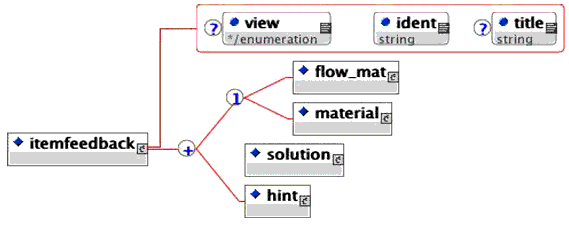
Multiplicity: Occurs zero or more times within the <item> element.
- title (optional). The title of the feedback section.
Data-type = String (max of 256 chars). - ident (required). The unique identifier for the feedback. This identifier is used within the <resprocessing> element to identify the feedback to be presented as a consequence of the processing of the user's response.
Data-type = String (max of 256 chars). - view (optional with selection from the enumerated list of: All, Administrator, AdminAuthority, Assessor, Author, Candidate, InvigilatorProctor, Psychometrician, Scorer, Tutor. Default=All). The view defines the scope for the display of the associated information i.e. to whom the material can be presented.
Data-type = Enumerated list.
3.5.27.1 <material> Element
Description: This element contains the feedback materials that are to be displayed to the participant as part of the question.
Multiplicity: Occurs zero or more times within the <itemfeedback> element.
Attributes: See sub-section 3.6.3.
3.5.27.2 <flow_mat> Element
Description: This element contains the feedback materials that are to be displayed to the participant.
Multiplicity: Occurs zero or more times within the <itemfeedback> element.
Attributes: See sub-section 3.6.15.
3.5.28 <solution> Element
Description: The <solution> element contains the solution(s) that are to be revealed to the participant. When these solutions are revealed is outside the scope of the specification.
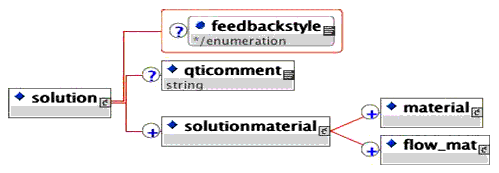
Multiplicity: Occurs zero or more times within the <itemfeedback> element.
- feedbackstyle (optional with selection from the enumerated list of: Complete, Incremental, Multilevel, Proprietary. Default=Complete). Defines the manner in which the feedback is constructed and is to be revealed to the participant.
Data-type = Enumerated list.
3.5.28.1 <qticomment> Element
Description: This element contains the comments that are relevant to the Solution as a whole.
Multiplicity: Occurs zero or once within the <solution> element.
Attributes: See sub-section 3.6.1.
3.5.29 <solutionmaterial> Element
Description: This is the container for the materials to be presented to the participant as the recommended solution. The solution can be revealed in a variety of ways but this information is not contained within the material being displayed.
Multiplicity: Occurs once or more times within the <solution> element.
3.5.29.1 <material> Element
Description: This element contains the feedback materials that are to be displayed to the participant.
Multiplicity: Occurs zero or more times within the <solutionmaterial> element.
Attributes: See sub-section 3.6.3.
3.5.29.2 <flow_mat> Element
Description: This element contains the feedback materials that are to be displayed to the participant.
Multiplicity: Occurs zero or more times within the <solutionmaterial> element.
Attributes: See sub-section 3.6.15.
3.5.30 <hint> Element
Description: The <hint> element contains the hint(s) that are to be revealed to the participant. When these hints are revealed is outside the scope of the specification.
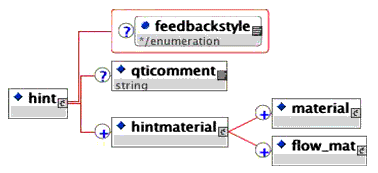
Multiplicity: Occurs zero or more times within the <itemfeedback> element.
- feedbackstyle (optional with selection from the enumerated list of: Complete, Incremental, Multilevel, Proprietary. Default=Complete). Defines the manner in which the feedback is constructed and is to be revealed to the participant.
Data-type = Enumerated list.
3.5.30.1 <qticomment> Element
Description: This element contains the comments that are relevant to the Hint as a whole.
Multiplicity: Occurs zero or once within the <hint> element.
Attributes: See sub-section 3.6.1.
3.5.31 <hintmaterial> Element
Description: This is the container for the materials to be presented to the participant as a hint. The hint can be revealed in a variety of ways but this information is not contained within the material being displayed.
Multiplicity: Occurs once or more times within the <hint> element.
3.5.31.1 <material> Element
Description: This element contains the feedback materials that are to be displayed to the participant.
Multiplicity: Occurs zero or more times within the <hintmaterial> element.
Attributes: See sub-section 3.6.3.
3.5.31.2 <flow_mat> Element
Description: This element contains the feedback materials that are to be displayed to the participant.
Multiplicity: Occurs zero or more times within the <hintmaterial> element.
Attributes: See sub-section 3.6.15.
3.6 Common Data Elements
The common elements that are defined in this sub-section are:
- qticomment - comments that are parsed through the XML parser;
- duration - the duration permitted for a particular activity;
- material - the container for the materials to be displayed to the participant;
- altmaterial - the container for the display of alternative content when the primary material cannot be rendered;
- mattext - the container for text content to be displayed to the participant;
- matemtext - the container for emphasized text content to be displayed to the participant;
- matbreak - to force a break in the flow of the associated content;
- matimage - the container for image content to be displayed to the participant;
- mataudio - the container for audio content to be displayed to the participant;
- matvideo - the container for video content to be displayed to the participant;
- matapplet - the container for applet content to be displayed to the participant;
- matapplication - the container for application content to be displayed to the participant;
- mat_ref - the container for a referential link to the required material;
- mat_extension - the extension facility for the <material> element;
- flow_mat - the container for the block structured materials to be displayed to the participant;
- qtimetadata - the container for the QTI-specific meta-data fields;
- objectives - the objectives to be revealed to the participants;
- rubric - the rubric to be revealed to the participants;
- decvar - enables the declaration of the variables used to support the scoring systems;
- interpretvar - allows statistical information to be associated with the scoring variables;
- setvar - is used to change the state of a scoring variable;
- displayfeedback - used to trigger the associated feedback as a result of the response processing;
- conditionvar - the application of the test conditions to detect the nature of the user responses;
3.6.1 <qticomment> Element
Description: This element contains the comments that are relevant to the host element. The comment is contained as a string.
3.6.2 <duration> Element
Description: The duration permitted for the completion of a particular activity. The duration is defined as per the ISO8601 standard. The information is entered as a string.
3.6.3 <material> Element
Description: This is the container for any content that is to be displayed by the question-engine. The supported content types are text (emphasized or not), images, audio, video, application and applet. The content can be internally referenced to avoid the need for duplicate copies. Alternative information can be defined - this is used if the primary content cannot be displayed.
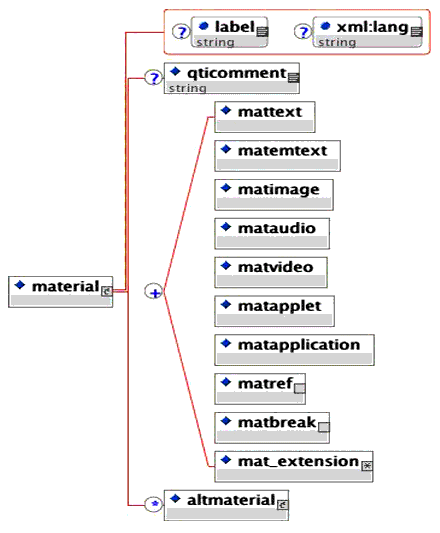
- label (optional). A label that can be used by authoring tools to identify key features.
Data-type = String (max of 256 chars).
- qticomment
- mattext
- matemtext
- matimage
- mataudio
- matvideo
- matapplet
- matapplication
- matref
- matbreak
- mat_extension
- altmaterial
3.6.4 <altmaterial> Element
Description: This is the container for alternative content. This content is to be displayed if, for whatever reason, the primary content cannot be rendered. Alternative language implementations of the host <material> element are also supported using this structure.
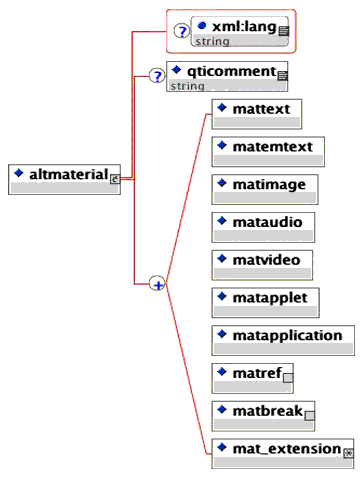
|
Multiplicity: This occurs zero or more times within the <material> element. |
- qticomment
- mattext
- matemtext
- matimage
- mataudio
- matvideo
- matapplet
- matapplication
- matref
- matbreak
- mat_extension
3.6.5 <mattext> Element
Description: The <mattext> element contains any text that is to be displayed to the users.
Multiplicity: This occurs zero or more times within the <material> element.
- texttype (optional. Default='text/plain'). This identifies the type of text string. The format of the string is as defined by RFC1521.
Data-type = String (max of 32 chars). - charset (optional. Default='ascii-us'). The character set that is to be used to represent the text string.
Data-type = String (max of 32 chars). - label (optional). A label that is used to uniquely identify the text content.
Data-type = String (max of 256 chars). - uri (optional). The 'uri' identifying the external reference that contains the text to be presented.
Data-type = String (max of 256 chars). - entityref (optional). An alternative mechanism for identifying the external reference that contains the text to be presented. This allows the file reference to be bound to the XML instance itself.
Data-type = String (max of 256 chars).
3.6.6 <matemtext> Element
Description: The <matemtext> element contains any emphasized text that is to be displayed to the users. The type of emphasis is dependent on the question-engine rendering the text.
Multiplicity: This occurs zero or more times within the <material> element.
- texttype (optional. Default='text/plain'). This identifies the type of text string. The format of the string is as defined by RFC1521.
Data-type = String (max of 32 chars). - charset (optional. Default='ascii-us'). The character set that is to be used to represent the text string.
Data-type = String (max of 32 chars). - label (optional). A label that is used to uniquely identify the text content.
Data-type = String (max of 256 chars). - uri (optional). The 'uri' identifying the external reference that contains the text to be presented.
Data-type = String (max of 256 chars). - entityref (optional). An alternative mechanism for identifying the external reference that contains the text to be presented. This allows the file reference to be bound to the XML instance itself.
Data-type = String (max of 256 chars).
3.6.7 <matbreak> Element
Description: The element that is used to insert a break in the flow of the associated material. The nature of the 'break' is dependent on the display-rendering engine.
Multiplicity: This occurs zero or more times within the <material> element.
3.6.8 <matimage> Element
Description: The <matimage> element is used to contain image content that is to be displayed to the users.
Multiplicity: This occurs zero or more times within the <material> element.
- imagtype (optional. Default='image/jpeg'). This identifies the type of image. The format of the string is as defined by RFC1521.
Data-type = String (max of 32 chars). - label (optional). A label that is used to uniquely identify the image content.
Data-type = String (max of 256 chars). - uri (optional). The 'uri' identifying the external reference that contains the image to be presented.
Data-type = String (max of 256 chars). - entityref (optional). An alternative mechanism for identifying the external reference that contains the image to be presented. This allows the file reference to be bound to the XML instance itself.
Data-type = String (max of 256 chars).
- x0 (optional). The top left hand X-co-ordinate point for the content.
Data-type = String (max of 4 chars representing an integer in the range 0-231-1). - y0 (optional). The top left hand Y-co-ordinate point for the content.
Data-type = String (max of 4 chars representing an integer in the range 0-231-1). - embedded (optional. Default='Base64'). This defines the nature of the encoding of the image if it is embedded within the XML instance itself.
Data-type = String (max of 32 chars).
3.6.9 <mataudio> Element
Description: The <mataudio> element is used to contain audio content that is to be displayed to the users.
Multiplicity: This occurs zero or more times within the <material> element.
- audiotype (optional. Default='audio/base'). This identifies the type of audio. The format of the string is as defined by RFC1521.
Data-type = String (max of 32 chars). - label (optional). A label that is used to uniquely identify the audio content.
Data-type = String (max of 256 chars). - uri (optional). The 'uri' identifying the external reference that contains the audio to be presented.
Data-type = String (max of 256 chars). - entityref (optional). An alternative mechanism for identifying the external reference that contains the image to be presented. This allows the file reference to be bound to the XML instance itself.
Data-type = String (max of 256 chars). - embedded (optional. Default='Base64'). This defines the nature of the encoding of the audio file if it is embedded within the XML instance itself.
Data-type = String (max of 32 chars).
3.6.10 <matvideo> Element
Description: The <matvideo> element is used to contain video content that is to be displayed to the users.
Multiplicity: This occurs zero or more times within the <material> element.
- videotype (optional. Default='video/mpeg'). This identifies the type of video. The format of the string is as defined by RFC1521.
Data-type = String (max of 32 chars). - label (optional). A label that is used to uniquely identify the video content.
Data-type = String (max of 256 chars). - uri (optional). The 'uri' identifying the external reference that contains the video to be presented.
Data-type = String (max of 256 chars). - entityref (optional). An alternative mechanism for identifying the external reference that contains the video to be presented. This allows the file reference to be bound to the XML instance itself.
Data-type = String (max of 256 chars).
- x0 (optional). The top left hand X-co-ordinate point for the content.
Data-type = String (max of 4 chars representing an integer in the range 0-231-1). - y0 (optional). The top left hand Y-co-ordinate point for the content.
Data-type = String (max of 4 chars representing an integer in the range 0-231-1). - embedded (optional. Default='Base64'). This defines the nature of the encoding of the video if it is embedded within the XML instance itself.
Data-type = String (max of 32 chars).
3.6.11 <matapplet> Element
Description: The <matapplet> element is used to contain applet content that is to be displayed to the users. Parameters that are to be passed to the applet being launched should be enclosed in a CDATA block within the content of the <matapplet> element.
Multiplicity: This occurs zero or more times within the <material> element.
- label (optional). A label that is used to uniquely identify the applet content.
Data-type = String (max of 256 chars). - uri (optional). The 'uri' identifying the external reference that contains the applet to be executed.
Data-type = String (max of 256 chars). - entityref (optional). An alternative mechanism for identifying the external reference that contains the applet to be presented. This allows the file reference to be bound to the XML instance itself.
Data-type = String (max of 256 chars).
- x0 (optional). The top left hand X-co-ordinate point for the content.
Data-type = String (max of 4 chars representing an integer in the range 0-231-1). - y0 (optional). The top left hand Y-co-ordinate point for the content.
Data-type = String (max of 4 chars representing an integer in the range 0-231-1). - embedded (optional. Default='Base64'). This defines the nature of the encoding of the applet if it is embedded within the XML instance itself.
Data-type = String (max of 32 chars).
3.6.12 <matapplication> Element
Description: The <matapplication> element is used to contain application content that is to be displayed to the users. Parameters that are to be passed to the application being launched should be enclosed in a CDATA block within the content of the <matapplication> element.
Multiplicity: This occurs zero or more times within the <material> element.
- apptype (optional). This identifies the type of application to be executed. The format of the string is as defined by RFC1521.
Data-type = String (max of 32 chars). - label (optional). A label that is used to uniquely identify the image content.
Data-type = String (max of 256 chars). - uri (optional). The 'uri' identifying the external reference that contains the application to be executed.
Data-type = String (max of 256 chars). - entityref (optional). An alternative mechanism for identifying the external reference that contains the application to be executed. This allows the file reference to be bound to the XML instance itself.
Data-type = String (max of 256 chars). - embedded (optional. Default='Base64'). This defines the nature of the encoding of the application if it is embedded within the XML instance itself.
Data-type = String (max of 32 chars).
3.6.13 <matref> Element
Description: The <matref> element is used to contain a reference to the required material. This material will have had an identifier assigned to enable such a reference to be reconciled when the instance is parsed into the system. <matref> should only be used to reference a material component and not a <material> element (the element <material_ref> should be used for the latter).
Multiplicity: This occurs zero or more times within the <material> element.
- linkrefid (required). The identifier of the content that is being referenced. This material will have been assigned by the label attribute of the associated <mattext>, <matemtext>, etc. elements.
Data-type = String (max of 256 chars).
3.6.14 <mat_extension> Element
Description: The extension facility to enable proprietary types of material to be included with the corresponding data object.
Multiplicity: This occurs zero or once within the <material> element.
3.6.15 <flow_mat> Element
Description: This element allows the materials to be displayed to the users to be grouped together using flows. The manner in which these flows are handled is dependent upon the display-engine.
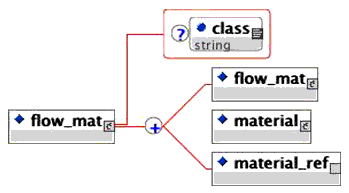
3.6.16 <qtimetadata> Element
Description: The container for all of the vocabulary-based QTI-specific meta-data. This structure is available to each of the four core ASI data structures.

3.6.16.1 <vocabulary> Element
Description: The vocabulary to be applied to the associated meta-data fields. The vocabulary is defined either using an external file or it is included as a comma separated list.
Multiplicity: Occurs zero or once within the <qtimetadata> element.
- uri (optional). The 'uri' identifying the external reference that contains the vocabulary.
Data-type = String (max of 256 chars). - entityref (optional). An alternative mechanism for identifying the external reference that contains the vocabulary. This allows the file reference to be bound to the XML instance itself.
Data-type = String (max of 256 chars).
3.6.16.2 <qtimetadatafield> Element
Description: The structure responsible for containing each of the QTI-specific meta-data fields.
Multiplicity: Occurs once or more times within the <qtimetadata> element.
- xml:lang (optional). The language of the text used for the meta-data entries.
Data-type = String (max of 32 chars).
3.6.16.3 <fieldlabel> Element
Description: Used to contain the name of the QTI-specific meta-data field.
Multiplicity: Occurs once within the <qtimetadatafield> element.
3.6.16.4 <fieldentry> Element
Description: Used to contain the actual data entry of the QTI-specific meta-data field named using the associated 'fieldlabel' element.
Multiplicity: Occurs once within the <qtimetadatafield> element.
3.6.17 <objectives> Element
Description: The objectives element is used to store the information that describes the educational aims of the Item. These objectives can be defined for each of the different 'view' perspectives. This element should not be used to contain information specific to an Item because the question-engine may not make this information available to the Item during the actual test.
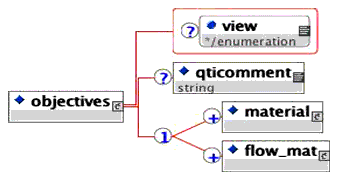
- view (optional with selection from the enumerated list of: All, Administrator, AdminAuthority, Assessor, Author, Candidate, InvigilatorProctor, Psychometrician, Scorer, Tutor. Default=All). The view defines the scope for the display of the associated information i.e. to whom the material can be presented.
Data-type = Enumerated list.
3.6.18 <rubric> Element
Description: The rubric element is used to contain contextual information that is important to the element e.g. it could contain standard data values that might or might not be useful for answering the question. Different sets of rubric can be defined for each of the possible 'views'. The material contained within the rubric must be displayed to the participant.
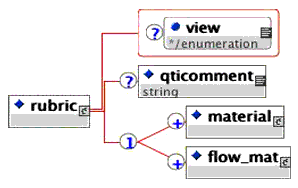
- view (optional with selection from the enumerated list of: All, Administrator, AdminAuthority, Assessor, Author, Candidate, InvigilatorProctor, Psychometrician, Scorer, Tutor. Default=All). The view defines the scope for the display of the associated information i.e. to whom the material can be presented.
Data-type = Enumerated list.
3.6.19 <decvar> Element
Description: The <decvar> element permits the declaration of the scoring variables.
- varname (optional. Default = 'SCORE'). The name of the variable that is to be declared. The default name is 'SCORE'. All numeric variables have the associated 'x.min', 'x.max' and 'x.normalised' variables declared.
Data-type = String (max of 256 chars). - vartype (required. Enumerated list: String, Decimal, Scientific, Boolean, Integer, Enumerated. Default=Integer). The type of the variable declared.
Data-type = Enumerated list. - defaultval (optional). The default value to which the variable is to be initialized. If this is not defined then the variable value should be set to zero.
Data-type = String (max of 16 chars). - cutvalue (optional). The value/grade above which, or equal to, the subject is considered to have been mastered.
Data-type = String (max of 16 chars). - minvalue (optional). The minimum value permitted for a numeric score.
Data-type = Numerical (max of 32 chars). - maxvalue (optional). The maximum value permitted for a numeric score.
Data-type = Numerical (max of 32 chars). - members (optional). The set of enumerated values that constitute the member. This is a comma separated list without enclosing brackets.
Data-type = String (max of 1024 chars).
3.6.20 <interpretvar> Element
Description: The <interpretvar> element is used to provide statistical interpretation information about the associated variables.

- varname (optional. Default = 'SCORE'). The name of the variable to which this interpretation information is related. The default name is 'SCORE'.
Data-type = String (max of 256 chars). - view (optional with selection from the enumerated list of: All, Administrator, AdminAuthority, Assessor, Author, Candidate, InvigilatorProctor, Psychometrician, Scorer, Tutor. Default=All). The view defines the scope for the display of the associated information i.e. to whom the material can be presented.
Data-type = Enumerated list.
3.6.21 <setvar> Element
Description: The <setvar> element is responsible for changing the value of the scoring variable as a result of the associated response processing test.
- varname (optional. Default = 'SCORE'). The name of the variable that is to be actioned. The default name is 'SCORE'.
Data-type = String (max of 256 chars). - action (optional - enumerated list: Set, Add, Subtract, Multiply, Divide. Default=Set). The action that is to be applied to the named variable.
Data-type = Enumerated list.
3.6.22 <displayfeedback> Element
Description: The <displayfeedback> element is responsible for assigning an associated feedback to the response processing if the 'True' state is created through the associated response processing condition test.
- feedbacktype (optional - enumerated list: Response, Solution, Hint. Default = Response). The type of feedback that has been triggered by the associated response condition.
Data-type = Enumerated list. - linkrefid (required). The identifier of the associated feedback. An <itemfeedback> element must exist with this identifier as defined by its 'ident' attribute.
Data-type = String (max of 256 chars).
3.6.23 <conditionvar> Element
Description: The conditional test that is to be applied to the user's response. A wide range of separate and combinatorial test can be applied.
- qticomment
- not
- and
- or
- unanswered
- other
- varequal
- varlt
- varlte
- vargt
- vargte
- varsubset
- varinside
- varsubstring
- durequal
- durlte
- durgt
- durgte
- var_extension
3.6.23.1 <varequal> Element
Description: The <varequal> element is the test of equivalence. The data for the test is contained within the element's PCDATA string and must be the same as one of the <response_label> values (this were assigned using the ident attribute).
Multiplicity: This occurs zero or more times within the <conditionvar>, <and>, <or> and <not> elements.
- respident (required). The identifier of the corresponding <response_lid>, <response_xy>, etc. element (this was assigned using its ident attribute).
Data-type = String (max of 32 chars). - case (optional - enumerated list: Yescase, Nocase. Default = Yescase). Defines the nature of the comparison when operating on strings i.e. case sensitive or not.
Data-type = Enumerated list.
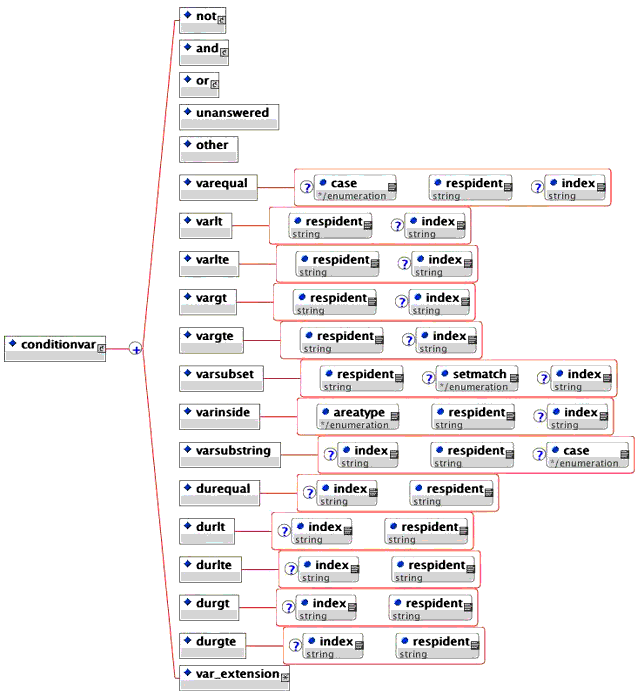
3.6.23.2 <varlt> Element
Description: The <varlt> element is the 'less than' test. The data for the test is contained within the element's PCDATA string and is assumed to be numerical in nature.
Multiplicity: This occurs zero or more times within the <conditionvar>, <and>, <or> and <not> elements.
- respident (required). The identifier of the corresponding <response_lid>, <response_xy>, etc. element (this was assigned using its ident attribute).
Data-type = String (max of 32 chars).
3.6.23.3 <varlte> Element
Description: The <varlte> element is the 'less than or equal' test. The data for the test is contained within the element's PCDATA string and is assumed to be numerical in nature.
Multiplicity: This occurs zero or more times within the <conditionvar>, <and>, <or> and <not> elements.
- respident (required). The identifier of the corresponding <response_lid>, <response_xy>, etc. element (this was assigned using its ident attribute).
Data-type = String (max of 32 chars).
3.6.23.4 <vargt> Element
Description: The <vargt> element is the 'greater than' test. The data for the test is contained within the element's PCDATA string and is assumed to be numerical in nature.
Multiplicity: This occurs zero or more times within the <conditionvar>, <and>, <or> and <not> elements.
- respident (required). The identifier of the corresponding <response_lid>, <response_xy>, etc. element (this was assigned using its ident attribute).
Data-type = String (max of 32 chars).
3.6.23.5 <vargte> Element
Description: The <vargte> element is the 'greater than or equal to' test. The data for the test is contained within the element's PCDATA string and is assumed to be numerical in nature.
Multiplicity: This occurs zero or more times within the <conditionvar>, <and>, <or> and <not> elements.
- respident (required). The identifier of the corresponding <response_lid>, <response_xy>, etc. element (this was assigned using its ident attribute).
Data-type = String (max of 32 chars).
3.6.23.8 <varinside> Element
Description: The <varinside> element is the 'xy-co-ordinate inside an area' test. The data for the test is contained within the element's PCDATA string and is a set of co-ordinates that define the area.
Multiplicity: This occurs zero or more times within the <conditionvar>, <and>, <or> and <not> elements.
- respident (required). The identifier of the corresponding <response_lid>, <response_xy>, etc. element (this was assigned using its ident attribute).
Data-type = String (max of 32 chars).
- areatype (required - enumerated list: Ellipse, Rectangle, Bounded). Defines the type of area that is to be used for the xy-coordinate test.
Data-type = Enumerated list.
3.6.23.9 <durequal> Element
Description: The <durequal> element is the 'duration equal to' test i.e. a test on the time taken to make the response. The data for the test is contained within the element's PCDATA string and is a set of co-ordinates that define the area. This is for further study in Version 2.0.
Multiplicity: This occurs zero or more times within the <conditionvar>, <and>, <or> and <not> elements.
3.6.23.10 <durlt> Element
Description: The <durlt> element is the 'duration less than' test i.e. a test on the time taken to make the response. The data for the test is contained within the element's PCDATA string and is a set of co-ordinates that define the area. This is for further study in Version 2.0.
Multiplicity: This occurs zero or more times within the <conditionvar>, <and>, <or> and <not> elements.
3.6.23.11 <durlte> Element
Description: The <durlte> element is the 'duration less than or equal to' test i.e. a test on the time taken to make the response. The data for the test is contained within the element's PCDATA string and is a set of co-ordinates that define the area. This is for further study in Version 2.0.
Multiplicity: This occurs zero or more times within the <conditionvar>, <and>, <or> and <not> elements.
3.6.23.12 <durgt> Element
Description: The <durgt> element is the 'duration greater than' test i.e. a test on the time taken to make the response. The data for the test is contained within the element's PCDATA string and is a set of co-ordinates that define the area. This is for further study in Version 2.0.
Multiplicity: This occurs zero or more times within the <conditionvar>, <and>, <or> and <not> elements.
3.6.23.13 <durgte> Element
Description: The <durgte> element is the 'duration greater than or equal to' test i.e. a test on the time taken to make the response. The data for the test is contained within the element's PCDATA string and is a set of co-ordinates that define the area. This is for further study in Version 2.0.
Multiplicity: This occurs zero or more times within the <conditionvar>, <and>, <or> and <not> elements.
3.6.23.14 <not> Element
Description: The <not> element inverts the logical test outcome that is required. In the case of the <varequal> element produces a 'not equals' test.
Multiplicity: This occurs zero or more times within the <conditionvar>, <and>, <or> and <not> elements.
- not
- and
- or
- unanswered
- other
- varequal
- varlt
- varlte
- vargt
- vargte
- varsubset
- varsubstring
- varinside
- durequal
- durlte
- durgt
- durgte
3.6.23.15 <and> Element
Description: The <and> element is used to create the Boolean 'AND' operation between the two or more enclosed tests. The result 'True' is returned if all of the tests return a 'True' value.
Multiplicity: This occurs zero or more times within the <conditionvar>, <and>, <or> and <not> elements.
- not
- and
- or
- unanswered
- other
- varequal
- varlt
- varlte
- vargt
- vargte
- varsubset
- varsubstring
- varinside
- durequal
- durlte
- durgt
- durgte
3.6.23.16 <or> Element
Description: The <or> element is used to create the Boolean 'OR' operation between the two or more enclosed tests. The result 'True' is returned if one or more of the tests return a 'True' value.
Multiplicity: This occurs zero or more times within the <conditionvar>, <and>, <or> and <not> elements.
- not
- and
- or
- unanswered
- other
- varequal
- varlt
- varlte
- vargt
- vargte
- varsubset
- varsubstring
- varinside
- durequal
- durlte
- durgt
- durgte
3.6.23.17 <unanswered> Element
Description: The <unanswered> element is the condition to be applied if a response is not received for the Item i.e. it is unanswered.
Multiplicity: This occurs zero or more times within the <conditionvar>, <and>, <or> and <not> elements.
3.6.23.18 <other > Element
Description: The <other> element is used to trigger the condition when all of the other tests have not returned a 'True' state.
Multiplicity: This occurs zero or more times within the <conditionvar>, <and>, <or> and <not> elements.
3.6.23.19 <var_extension> Element
Description: This element contains proprietary extensions to be applied to condition tests. This enables vendors to create their own conditional tests to be used on the participant responses.
Multiplicity: Occurs zero or once within the <conditionvar> element.

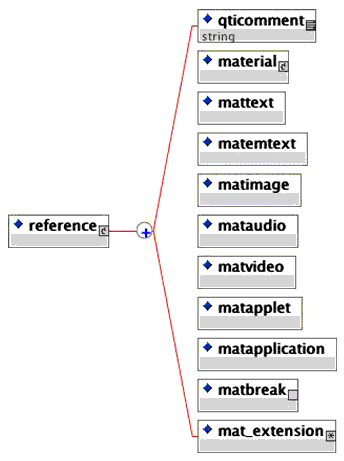
4. V1.2 Compliant Example XML Instances4.1 Item XML Instance |
<questestinterop>
<qticomment>
This example consists of two Items.
</qticomment>
<item title="Capital of France" ident="I01" maxattempts="6">
<qticomment>
This Item is also available in the accompanying example files.
</qticomment>
<rubric view="Candidate">
<flow_mat>
<material>
<mattext>Choose only one of the choices available.</mattext>
</material>
</flow_mat>
</rubric>
<presentation label="Resp001">
<flow>
<material>
<mattext>What is the Capital of France ?</mattext>
</material>
<response_lid ident="LID01">
<render_choice shuffle="Yes">
<flow_label>
<response_label ident="LID01_A">
<material><mattext>London</mattext></material>
</response_label>
</flow_label>
<flow_label>
<response_label ident="LID01_B">
<material><mattext>Paris</mattext></material>
</response_label>
</flow_label>
<flow_label>
<response_label ident="LID01_C">
<material><mattext>Washington</mattext></material>
</response_label>
</flow_label>
<flow_label>
<response_label ident="LID01_D" rshuffle="No">
<material><mattext>Berlin</mattext></material>
</response_label>
</flow_label>
</render_choice>
</response_lid>
</flow>
</presentation>
<resprocessing>
<qticomment/>
<outcomes>
<decvar vartype="Integer" defaultval="0" minvalue="0" maxvalue="10"/>
</outcomes>
|
<respcondition>
<qticomment>Scoring for the correct answer.</qticomment>
<conditionvar>
<varequal respident="LID01">LID01_B</varequal>
</conditionvar>
<setvar action="Set" varname="SCORE">10</setvar>
<displayfeedback feedbacktype="Response" linkrefid="I01_IFBK01"/>
</respcondition>
</resprocessing>
<itemfeedback title="Correct answer" ident="I01_IFBK01">
<flow_mat>
<material>
<mattext>Correct answer.</mattext>
</material>
</flow_mat>
</itemfeedback>
<itemfeedback ident="I01_IFBK02">
<solution>
<solutionmaterial>
<flow_mat>
<material>
<mattext>
London is the Capital of England.
Paris is the Capital of France.
Washington is in the USA.
Berlin is the Capital of Germany.
</mattext>
</material>
</flow_mat>
</solutionmaterial>
</solution>
</itemfeedback>
<itemfeedback ident="I01_IFBK03" view="All">
<hint feedbackstyle="Multilevel">
<hintmaterial>
<flow_mat>
<material>
<mattext>One of the choices is not in Europe.</mattext>
</material>
</flow_mat>
</hintmaterial>
<hintmaterial>
<flow_mat>
<material>
<mattext>Berlin is the Capital of Germany.</mattext>
</material>
</flow_mat>
</hintmaterial>
<hintmaterial>
<flow_mat>
<material>
<mattext>The Eiffel tower is in the Capital of France.</mattext>
</material>
</flow_mat>
</hintmaterial>
</hint>
</itemfeedback>
</item>
</questestinterop>
|
4.2 Section XML Instance
The following example consists of one section (with flow) that contains one Item (with flow).
<questestinterop>
<qticomment>
This example consists of one Sections.
</qticomment>
<section title="European Capitals" ident="IMS_V01_S_Example201">
<objectives view="Candidate">
<flow_mat>
<material>
<mattext>To assess knowledge of the capital cities in Europe.</mattext>
</material>
</flow_mat>
</objectives>
<objectives view="Tutor">
<flow_mat>
<material>
<mattext>
To ensure that the student knows the difference between the Capital
cities of France, UK, Germany, Spain and Italy.
</mattext>
</material>
</flow_mat>
</objectives>
<presentation_material>
<flow_mat>
<material>
<mattext>Attempt all questions.</mattext>
</material>
</flow_mat>
</presentation_material>
<reference>
<mattext label="CorrectFeedback">Correct answer.</mattext>
</reference>
<item title="Capital of France" ident="I01" maxattempts="6">
<qticomment>
This Item is also available in the accompanying example files.
</qticomment>
<itemmetadata/>
<rubric view="Candidate">
<flow_mat>
<material>
<mattext>Choose only one of the choices available.</mattext>
</material>
</flow_mat>
</rubric>
<presentation label="Resp001">
<flow>
<material>
<mattext>What is the Capital of France ?</mattext>
</material>
<response_lid ident="LID01">
<render_choice shuffle="Yes" minnumber="0" maxnumber="1">
<flow_label>
<response_label ident="LID01_A">
<material><mattext>London</mattext></material>
</response_label>
</flow_label>
|
<flow_label>
<response_label ident="LID01_B">
<material><mattext>Paris</mattext></material>
</response_label>
</flow_label>
<flow_label>
<response_label ident="LID01_C">
<material><mattext>Washington</mattext></material>
</response_label>
</flow_label>
<flow_label>
<response_label ident="LID01_D" rshuffle="No">
<material><mattext>Berlin</mattext></material>
</response_label>
</flow_label>
</render_choice>
</response_lid>
</flow>
</presentation>
<resprocessing>
<qticomment/>
<outcomes>
<decvar vartype="Integer" defaultval="0" minvalue="0" maxvalue="10"/>
</outcomes>
<respcondition>
<qticomment>Scoring for the correct answer.</qticomment>
<conditionvar>
<varequal respident="LID01">LID01_B</varequal>
</conditionvar>
<setvar action="Set" varname="SCORE">10</setvar>
<displayfeedback feedbacktype="Response" linkrefid="I01_IFBK01"/>
</respcondition>
</resprocessing>
<itemfeedback title="Correct answer" ident="I01_IFBK01">
<flow_mat>
<material>
<matref label="CorrectFeedback"/>
</material>
</flow_mat>
</itemfeedback>
<itemfeedback ident="I01_IFBK02">
<solution>
<solutionmaterial>
<flow_mat>
<material>
<mattext>
London is the Capital of England.
Paris is the Capital of France.
Washington is in the USA.
Berlin is the Capital of Germany.
</mattext>
</material>
</flow_mat>
</solutionmaterial>
</solution>
</itemfeedback>
<itemfeedback ident="I01_IFBK03" view="All">
<hint feedbackstyle="Multilevel">
<hintmaterial>
<flow_mat>
|
<material>
<mattext>One of the choices is not in Europe.</mattext>
</material>
</flow_mat>
</hintmaterial>
<hintmaterial>
<flow_mat>
<material>
<mattext>Berlin is the Capital of Germany.</mattext>
</material>
</flow_mat>
</hintmaterial>
<hintmaterial>
<flow_mat>
<material>
<mattext>The Eiffel tower is in the Capital of France.</mattext>
</material>
</flow_mat>
</hintmaterial>
</hint>
</itemfeedback>
</item>
</section>
</questestinterop>
|
4.3 Assessment Schema Instance
The following example consists of one Assessment (with flow) with two Sections (with flow). One Section contains two Items (with flow) and the other contains one Item.
<questestinterop>
<assessment title="European Geography" ident="A01">
<qticomment>A Complex Assessment example.</qticomment>
<objectives view="Candidate">
<flow_mat>
<material>
<mattext>To test your knowledge of European geography.</mattext>
</material>
</flow_mat>
</objectives>
<objectives view="Assessor">
<flow_amt>
<material>
<mattext>Tests the candidate's knowledge of European geography.</mattext>
</material>
</fow_mat>
</objectives>
<rubric view="Candidate">
<flow_mat>
<material>
<mattext>Attempt all questions.</mattext>
</material>
</flow_mat>
</rubric>
<presentation_material>
<flow_mat>
<material>
<mattext>All of the following questions are about Europe.</mattext>
</material>
|
</flow_mat>
</presentation_material>
<section title="European Capitals" ident="S01">
<objectives view="Candidate">
<flow_mat>
<material>
<mattext>To assess your knowledge of the capital cities in Europe.
</mattext>
</material>
</flow_mat>
</objectives>
<objectives view="Tutor">
<flow_mat>
<material>
<mattext>
To ensure that the student knows the difference between the Capital
cities of France, UK, Germany, Spain and Italy.
</mattext>
</material>
</flow_mat>
</objectives>
<rubric view="Candidate">
<flow_mat>
<material>
<mattext>Attempt all questions.</mattext>
</material>
</flow_mat>
</rubric>
<item title="Capital of France" ident="I01" maxattempts="6">
<rubric view="Candidate">
<flow_mat>
<material>
<mattext>Choose only one of the choices available.</mattext>
</material>
</flow_mat>
</rubric>
<presentation label="Resp001">
<flow>
<response_lid ident="LID01">
<material>
<mattext>What is the Capital of France ?</mattext>
</material>
<render_choice shuffle="Yes">
<response_label ident="LID01_A">
<flow_mat>
<material><mattext>London</mattext></material>
</flow_mat>
</response_label>
<response_label ident="LID01_B">
<flow_mat>
<material><mattext>Paris</mattext></material>
</flow_mat>
</response_label>
<response_label ident="LID01_C">
<flow_mat>
<material><mattext>Washington</mattext></material>
</flow_mat>
</response_label>
<response_label ident="LID01_D" rshuffle="No">
|
<flow_mat>
<material><mattext>Berlin</mattext></material>
</flow_mat>
</response_label>
</render_choice>
</response_lid>
</flow>
</presentation>
<resprocessing>
<outcomes>
<decvar vartype="Integer" defaultval="0"/>
</outcomes>
<respcondition>
<qticomment>Scoring for the correct answer.</qticomment>
<conditionvar>
<varequal respident="LID01">LID01_B</varequal>
</conditionvar>
<setvar action="Set" varname="SCORE">10</setvar>
<displayfeedback feedbacktype="Response" linkrefid="I01_IFBK01"/>
</respcondition>
</resprocessing>
<itemfeedback title="Correct answer" ident="I01_IFBK01">
<flow_mat>
<material><mattext>Correct answer.</mattext></material>
</flow_mat>
</itemfeedback>
<itemfeedback ident="I01_IFBK02">
<solution>
<solutionmaterial>
<flow_mat>
<material>
<mattext>London is the Capital of England.</mattext>
</material>
</flow_mat>
<flow_mat>
<material>
<mattext>Paris is the Capital of France.</mattext>
</material>
</flow_mat>
<flow_mat>
<material>
<mattext>Washington is in the USA.</mattext>
</material>
</flow_mat>
<flow_mat>
<material>
<mattext>Berlin is the Capital of Germany.</mattext>
</material>
</flow_mat>
</solutionmaterial>
</solution>
</itemfeedback>
<itemfeedback ident="I01_IFBK03" view="All">
<hint feedbackstyle="Multilevel">
<hintmaterial>
<flow_mat>
<material>
<mattext>One of the choices is not in Europe.</mattext>
</material>
|
</flow_mat>
</hintmaterial>
<hintmaterial>
<flow_mat>
<material>
<mattext>Berlin is the Capital of Germany.</mattext>
</material>
</flow_mat>
</hintmaterial>
<hintmaterial>
<flow_mat>
<material>
<mattext>The Eiffel tower is in the Capital of France.
</mattext>
</material>
</flow_mat>
</hintmaterial>
</hint>
</itemfeedback>
</item>
</section>
<section title="European Rivers" ident="SO2">
<objectives view="Candidate">
<flow_mat>
<material>
<mattext>To assess your knowledge of the rivers in Europe.</mattext>
</material>
</flow_mat>
</objectives>
<objectives view="Assessor">
<flow_mat>
<material>
<mattext>Questions on rivers in Germany, Spain, Italy and France.
</mattext>
</material>
</flow_mat>
</objectives>
<item title="Rivers in France question" ident="I02">
<rubric view="Candidate">
<flow_mat>
<material>
<mattext>Choose all of the correct answers.</mattext>
</material>
</flow_mat>
</rubric>
<presentation label="Resp002">
<flow>
<material>
<mattext>Which rivers are in France ?</mattext>
</material>
<response_lid ident="LID02" rcardinality="Multiple">
<render_choice shuffle="Yes" minnumber="1" maxnumber="2">
<response_label ident="LID02_A">
<flow_mat>
<material><mattext>Seine</mattext></material>
</flow_mat>
</response_label>
<response_label ident="LID02_B">
<flow_mat>
|
<material><mattext>Thames</mattext></material>
</flow_mat>
</response_label>
<response_label ident="LID02_C">
<flow_mat>
<material><mattext>Danube</mattext></material>
</flow_mat>
</response_label>
<response_label ident="LID02_D">
<flow_mat>
<material><mattext>Loire</mattext></material>
</flow_mat>
</response_label>
</render_choice>
</response_lid>
</flow>
</presentation>
</item>
<item title="Rivers in Germany" ident="I03"/>
<rubric view="Candidate">
<flow_mat>
<material>
<mattext>Choose all of the correct answers.</mattext>
</material>
</flow_mat>
</rubric>
<presentation label="Resp003">
<flow>
<material>
<matimage imagtytpe="image/gif" uri="rivers.gif"></matimage>
<mattext>Which rivers are in Germany ?</mattext>
</material>
<response_lid ident="LID03" rcardinality="Multiple">
<render_hotspot x0="500" y0="500" height="200">
<response_label ident="LID03_A" rarea="Ellipse">10,10,2,2
</response_label>
<response_label ident="LID03_B" rarea="Ellipse">15,15,2,2
</response_label>
<response_label ident="LID03_C" rarea="Ellipse">30,30,2,2
</response_label>
<response_label ident="LID03_D" rarea="Ellipse">60,60,2,2
</response_label>
<response_label ident="LID03_E" rarea="Ellipse">70,70,2,2
</response_label>
</render_hotspot>
</response_lid>
</flow>
</presentation>
</item>
</section>
</assessment>
</questestinterop>
|
About This Document
| Title | 1EdTech Question & Test Interoperability: ASI XML Binding Specification |
| Editors | Colin Smythe, Eric Shepherd, Lane Brewer, and Steve Lay |
| Version | 1.2 |
| Version Date | 11 February 2002 |
| Status | Final Specification |
| Summary | This document describes the 1EdTech Question & Test Interoperability: ASI XML binding for the corresponding information model. The XML encoding is based on the W3C XML Schema specification agreed in May, 2001. |
| Revision Information | 22 January 2002 |
| Purpose | Defines how the Question & Test Interoperability: ASI Information Model is encoded in XML by 1EdTech. |
| Document Location | http://www.imsglobal.org/question/v1p2/imsqti_asi_bindv1p2.html |
List of Contributors
The following individuals contributed to the development of this document:
Revision History
Index
A
Administrator 1, 2, 3, 4, 5, 6, 7, 8, 9
ASI 1, 2, 3, 4, 5, 6, 7, 8, 9, 10
Assessment 1, 2, 3, 4, 5, 6, 7, 8, 9, 10
Assessment Elements
assessfeedback 1, 2, 3
assessment 1, 2, 3, 4, 5, 6, 7, 8, 9, 10, 11, 12, 13, 14, 15
assessmentcontrol 1, 2, 3
assessproc_extension 1, 2
Assessor 1, 2, 3, 4, 5, 6, 7, 8, 9, 10, 11
Attributes
action 1, 2, 3, 4
apptype 1
areatype 1
audiotype 1
case 1, 2, 3, 4
charset 1, 2
class 1, 2, 3, 4
columns 1
continue 1
cutvalue 1
defaultval 1, 2, 3, 4
embedded 1, 2, 3, 4
encoding 1, 2, 3, 4, 5
entityref 1, 2, 3, 4, 5, 6
feedbackstyle 1, 2, 3, 4, 5
feedbackswitch 1, 2, 3
feedbacktype 1, 2, 3, 4
height 1, 2, 3, 4, 5, 6, 7
hintswitch 1, 2, 3
ident 1, 2, 3, 4, 5, 6, 7, 8, 9, 10, 11, 12, 13, 14, 15, 16, 17, 18, 19, 20, 21, 22, 23, 24, 25, 26, 27, 28, 29, 30, 31, 32
imagtype 1
index 1, 2, 3, 4, 5, 6
label 1, 2, 3, 4, 5, 6, 7, 8, 9, 10, 11, 12, 13, 14, 15, 16, 17, 18
labelrefid 1
linkrefid 1, 2, 3, 4, 5, 6, 7, 8
lowerbound 1
match_group 1
match_max 1
maxattempts 1, 2, 3, 4
maxchars 1
maxnumber 1, 2, 3, 4, 5, 6
maxvalue 1, 2, 3
members 1
minnumber 1, 2, 3, 4, 5, 6
minvalue 1, 2, 3
numtype 1
orientation 1
prompt 1
rarea 1, 2
rcardinality 1, 2, 3, 4, 5, 6, 7
respident 1, 2, 3, 4, 5, 6, 7, 8, 9
rows 1
rrange 1
rshuffle 1, 2, 3, 4
rtiming 1, 2, 3, 4, 5
scoremodel 1, 2
setmatch 1
showdraw 1
shuffle 1, 2, 3, 4, 5
solutionswitch 1, 2, 3
startval 1
step 1
texttype 1
title 1, 2, 3, 4, 5, 6, 7, 8, 9, 10, 11, 12, 13, 14, 15, 16, 17
upperbound 1
uri 1, 2, 3, 4, 5, 6, 7
varname 1, 2, 3, 4, 5
vartype 1, 2, 3, 4
videotype 1
view 1, 2, 3, 4, 5, 6, 7, 8, 9, 10, 11, 12, 13, 14, 15, 16, 17, 18, 19, 20, 21, 22, 23
vocab_type 1
width 1, 2, 3, 4, 5, 6
x0 1, 2, 3, 4, 5, 6, 7
xmllang 1, 2, 3, 4, 5, 6, 7, 8, 9, 10, 11, 12
xmlspace 1, 2, 3, 4
y0 1, 2, 3, 4, 5, 6
Author 1, 2, 3, 4, 5, 6, 7, 8, 9
C
Candidate 1, 2, 3, 4, 5, 6, 7, 8, 9, 10, 11, 12, 13, 14, 15
Common Elements
altmaterial 1, 2, 3, 4
conditionvar 1, 2, 3, 4, 5, 6, 7, 8, 9, 10, 11, 12, 13, 14, 15
decvar 1, 2, 3, 4, 5, 6, 7
displayfeedback 1, 2, 3, 4, 5, 6, 7
duration 1, 2, 3, 4, 5, 6, 7
durequal 1, 2, 3, 4
durgt 1, 2, 3, 4
durgte 1, 2, 3, 4
durlt 1
durlte 1, 2, 3, 4
fieldentry 1
flow_mat 1, 2, 3, 4, 5, 6, 7, 8, 9, 10, 11, 12, 13, 14, 15, 16, 17, 18, 19, 20
interpretvar 1, 2, 3
mat_extension 1, 2, 3, 4, 5
matapplet 1, 2, 3, 4, 5
matapplication 1, 2, 3, 4, 5
mataudio 1, 2, 3, 4, 5
matbreak 1, 2, 3, 4, 5
matemtext 1, 2, 3, 4, 5, 6, 7
material 1, 2, 3, 4, 5, 6, 7, 8, 9, 10, 11, 12, 13, 14, 15, 16, 17, 18, 19, 20, 21, 22, 23, 24, 25, 26, 27, 28, 29, 30, 31, 32, 33, 34, 35, 36, 37, 38, 39, 40, 41, 42, 43, 44, 45, 46, 47, 48, 49, 50, 51, 52, 53, 54, 55
material_ref 1, 2, 3, 4, 5, 6, 7, 8, 9, 10, 11, 12, 13, 14, 15, 16, 17, 18, 19, 20, 21
matimage 1, 2, 3, 4, 5, 6
matref 1, 2, 3, 4
mattext 1, 2, 3, 4, 5, 6, 7, 8, 9, 10, 11, 12, 13, 14, 15, 16
matvideo 1, 2, 3, 4, 5
objectives 1, 2, 3, 4, 5, 6, 7, 8, 9, 10, 11, 12, 13, 14, 15, 16, 17, 18
order 1, 2, 3, 4, 5, 6
other 1, 2, 3, 4, 5, 6, 7, 8, 9, 10, 11
outcomes 1, 2, 3, 4, 5, 6, 7, 8, 9, 10
outcomes_processing 1, 2, 3, 4, 5
presentation_material 1, 2, 3, 4, 5, 6, 7, 8, 9, 10
qticomment 1, 2, 3, 4, 5, 6, 7, 8, 9, 10, 11, 12, 13, 14, 15, 16, 17, 18, 19, 20, 21, 22, 23, 24, 25, 26, 27, 28, 29, 30, 31, 32, 33, 34, 35
qtimetadata 1, 2, 3, 4, 5, 6, 7, 8, 9, 10, 11, 12
qtimetadatafield 1, 2
reference 1, 2, 3, 4, 5, 6, 7, 8, 9, 10, 11, 12, 13, 14, 15, 16, 17, 18, 19, 20, 21, 22, 23, 24, 25, 26, 27, 28, 29, 30
rubric 1, 2, 3, 4, 5, 6, 7, 8, 9, 10, 11, 12, 13, 14, 15, 16, 17, 18, 19
selection 1, 2, 3, 4, 5, 6, 7, 8, 9, 10, 11, 12, 13, 14, 15, 16, 17, 18, 19
selection_ordering 1, 2, 3, 4, 5
setvar 1, 2, 3, 4, 5, 6
unanswered 1, 2, 3
var_extension 1, 2
varequal 1, 2, 3, 4, 5, 6, 7, 8, 9
vargt 1, 2, 3, 4
vargte 1, 2, 3, 4
varinside 1, 2, 3, 4
varlt 1, 2, 3, 4
varlte 1, 2, 3, 4
varsubset 1, 2, 3, 4, 5
varsubstring 1, 2, 3, 4, 5
vocabulary 1, 2, 3
E
Elements
altmaterial 1, 2, 3, 4
assessfeedback 1, 2, 3
assessment 1, 2, 3, 4, 5, 6, 7, 8, 9, 10, 11, 12, 13, 14, 15
assessmentcontrol 1, 2, 3
assessproc_extension 1, 2
conditionvar 1, 2, 3, 4, 5, 6, 7, 8, 9, 10, 11, 12, 13, 14, 15
decvar 1, 2, 3, 4, 5, 6, 7
displayfeedback 1, 2, 3, 4, 5, 6, 7
duration 1, 2, 3, 4, 5, 6, 7
durequal 1, 2, 3, 4
durgt 1, 2, 3, 4
durgte 1, 2, 3, 4
durlt 1
durlte 1, 2, 3, 4
fieldentry 1
fieldlabel 1
flow 1, 2, 3, 4, 5, 6, 7, 8, 9, 10, 11, 12, 13, 14, 15, 16, 17, 18, 19, 20, 21, 22, 23, 24, 25, 26, 27, 28, 29, 30
flow_label 1, 2, 3, 4, 5, 6, 7, 8, 9
flow_mat 1, 2, 3, 4, 5, 6, 7, 8, 9, 10, 11, 12, 13, 14, 15, 16, 17, 18, 19, 20
hint 1, 2, 3, 4, 5, 6, 7, 8
hintmaterial 1, 2, 3, 4, 5, 6, 7
interpretvar 1, 2, 3
itemcontrol 1, 2
itemfeedback 1, 2, 3, 4, 5, 6, 7, 8, 9, 10, 11, 12
itemmetadata 1, 2, 3, 4, 5, 6
itempostcondition 1, 2
itemprecondition 1, 2
itemproc_extension 1, 2, 3
itemref 1, 2
itemrubric 1, 2
mat_extension 1, 2, 3, 4, 5
matapplet 1, 2, 3, 4, 5
matapplication 1, 2, 3, 4, 5
mataudio 1, 2, 3, 4, 5
matbreak 1, 2, 3, 4, 5
matemtext 1, 2, 3, 4, 5, 6, 7
material 1, 2, 3, 4, 5, 6, 7, 8, 9, 10, 11, 12, 13, 14, 15, 16, 17, 18, 19, 20, 21, 22, 23, 24, 25, 26, 27, 28, 29, 30, 31, 32, 33, 34, 35, 36, 37, 38, 39, 40, 41, 42, 43, 44, 45, 46, 47, 48, 49, 50, 51, 52, 53, 54, 55
material_ref 1, 2, 3, 4, 5, 6, 7, 8, 9, 10, 11, 12, 13, 14, 15, 16, 17, 18, 19, 20, 21
matimage 1, 2, 3, 4, 5, 6
matref 1, 2, 3, 4
mattext 1, 2, 3, 4, 5, 6, 7, 8, 9, 10, 11, 12, 13, 14, 15, 16
matvideo 1, 2, 3, 4, 5
objectbank 1, 2, 3
objectives 1, 2, 3, 4, 5, 6, 7, 8, 9, 10, 11, 12, 13, 14, 15, 16, 17, 18
order 1, 2, 3, 4, 5, 6
other 1, 2, 3, 4, 5, 6, 7, 8, 9, 10, 11
outcomes 1, 2, 3, 4, 5, 6, 7, 8, 9, 10
outcomes_processing 1, 2, 3, 4, 5
presentation 1, 2, 3, 4, 5, 6, 7, 8, 9, 10, 11, 12, 13, 14, 15, 16, 17, 18, 19, 20, 21, 22, 23, 24, 25, 26, 27, 28, 29, 30, 31, 32, 33, 34, 35, 36, 37, 38, 39
presentation_material 1, 2, 3, 4, 5, 6, 7, 8, 9, 10
qmd_feedbackpermitted 1, 2
qmd_hintspermitted 1, 2
qmd_itemtype 1, 2
qmd_levelofdifficulty 1, 2
qmd_material 1, 2
qmd_maximumscore 1, 2
qmd_renderingtype 1, 2
qmd_responsetype 1, 2
qmd_scoringpermitted 1, 2
qmd_solutionspermitted 1, 2
qmd_status 1, 2
qmd_timedependence 1, 2
qmd_timelimit 1, 2
qmd_toolvendor 1, 2
qmd_topic 1, 2
qmd_typeofsolution 1, 2
qmd_weighting 1, 2, 3
qticomment 1, 2, 3, 4, 5, 6, 7, 8, 9, 10, 11, 12, 13, 14, 15, 16, 17, 18, 19, 20, 21, 22, 23, 24, 25, 26, 27, 28, 29, 30, 31, 32, 33, 34, 35
qtimetadata 1, 2, 3, 4, 5, 6, 7, 8, 9, 10, 11, 12
qtimetadatafield 1, 2
questestinterop 1, 2, 3, 4, 5, 6, 7, 8, 9, 10, 11
reference 1, 2, 3, 4, 5, 6, 7, 8, 9, 10, 11, 12, 13, 14, 15, 16, 17, 18, 19, 20, 21, 22, 23, 24, 25, 26, 27, 28, 29, 30
render_choice 1, 2, 3, 4, 5, 6, 7, 8, 9, 10, 11, 12, 13, 14, 15, 16, 17, 18
render_extension 1, 2, 3, 4, 5, 6, 7
render_fib 1, 2, 3, 4, 5, 6, 7, 8
render_hotspot 1, 2, 3, 4, 5, 6, 7, 8, 9, 10, 11
render_slider 1, 2, 3, 4, 5, 6, 7
respcond_extension 1, 2
respcondition 1, 2, 3, 4, 5, 6, 7
response_extension 1, 2, 3
response_grp 1, 2, 3, 4, 5, 6, 7, 8, 9, 10
response_label 1, 2, 3, 4, 5, 6, 7, 8, 9, 10, 11, 12, 13, 14, 15, 16, 17
response_lid 1, 2, 3, 4, 5, 6, 7, 8, 9, 10, 11, 12, 13, 14, 15, 16, 17, 18, 19, 20, 21, 22
response_na 1, 2, 3, 4, 5
response_num 1, 2, 3, 4, 5, 6, 7, 8, 9, 10
response_str 1, 2, 3, 4, 5, 6, 7, 8, 9
response_xy 1, 2, 3, 4, 5, 6, 7, 8, 9, 10, 11, 12, 13, 14, 15, 16
resprocessing 1, 2, 3, 4, 5, 6, 7, 8, 9, 10, 11, 12, 13
rubric 1, 2, 3, 4, 5, 6, 7, 8, 9, 10, 11, 12, 13, 14, 15, 16, 17, 18, 19
section 1, 2, 3, 4, 5, 6, 7, 8, 9, 10, 11, 12, 13, 14, 15, 16, 17, 18, 19, 20, 21, 22, 23, 24, 25, 26, 27, 28
sectioncontrol 1, 2, 3
sectionfeedback 1, 2, 3
sectionpostcondition 1, 2
sectionprecondition 1, 2
sectionproc_extension 1, 2
sectionref 1, 2, 3, 4
selection 1, 2, 3, 4, 5, 6, 7, 8, 9, 10, 11, 12, 13, 14, 15, 16, 17, 18, 19
selection_ordering 1, 2, 3, 4, 5
setvar 1, 2, 3, 4, 5, 6
solution 1, 2, 3, 4, 5, 6
solutionmaterial 1, 2, 3, 4
unanswered 1, 2, 3
var_extension 1, 2
varequal 1, 2, 3, 4, 5, 6, 7, 8, 9
vargt 1, 2, 3, 4
vargte 1, 2, 3, 4
varinside 1, 2, 3, 4
varlt 1, 2, 3, 4
varlte 1, 2, 3, 4
varsubset 1, 2, 3, 4, 5
vocabulary 1, 2, 3
Extension Elements
assessproc_extension 1, 2
itemproc_extension 1, 2, 3
mat_extension 1, 2, 3, 4, 5
render_extension 1, 2, 3, 4, 5, 6, 7
respcond_extension 1, 2
response_extension 1, 2, 3
sectionproc_extension 1, 2
var_extension 1, 2
F
FIB 1
I
Interoperability structures
Assessment 1, 2, 3, 4, 5, 6, 7, 8, 9, 10
Item 1, 2, 3, 4, 5, 6, 7, 8, 9, 10, 11, 12, 13, 14, 15, 16, 17, 18, 19, 20, 21, 22, 23, 24, 25, 26, 27, 28, 29, 30, 31
Section 1, 2, 3, 4, 5, 6, 7, 8, 9, 10, 11, 12, 13, 14, 15, 16, 17, 18
Item 1, 2, 3, 4, 5, 6, 7, 8, 9, 10, 11, 12, 13, 14, 15, 16, 17, 18, 19, 20, 21, 22, 23, 24, 25, 26, 27, 28, 29, 30, 31
Item Elements
flow 1, 2, 3, 4, 5, 6, 7, 8, 9, 10, 11, 12, 13, 14, 15, 16, 17, 18, 19, 20, 21, 22, 23, 24, 25, 26, 27, 28, 29, 30
flow_label 1, 2, 3, 4, 5, 6, 7, 8, 9
hint 1, 2, 3, 4, 5, 6, 7, 8
hintmaterial 1, 2, 3, 4, 5, 6, 7
itemcontrol 1, 2
itemfeedback 1, 2, 3, 4, 5, 6, 7, 8, 9, 10, 11, 12
itemmetadata 1, 2, 3, 4, 5, 6
itempostcondition 1, 2
itemprecondition 1, 2
itemproc_extension 1, 2, 3
itemrubric 1, 2
presentation 1, 2, 3, 4, 5, 6, 7, 8, 9, 10, 11, 12, 13, 14, 15, 16, 17, 18, 19, 20, 21, 22, 23, 24, 25, 26, 27, 28, 29, 30, 31, 32, 33, 34, 35, 36, 37, 38, 39
render_choice 1, 2, 3, 4, 5, 6, 7, 8, 9, 10, 11, 12, 13, 14, 15, 16, 17, 18
render_extension 1, 2, 3, 4, 5, 6, 7
render_fib 1, 2, 3, 4, 5, 6, 7, 8
render_hotspot 1, 2, 3, 4, 5, 6, 7, 8, 9, 10, 11
render_slider 1, 2, 3, 4, 5, 6, 7
respcond_extension 1, 2
respcondition 1, 2, 3, 4, 5, 6, 7
response_extension 1, 2, 3
response_grp 1, 2, 3, 4, 5, 6, 7, 8, 9, 10
response_label 1, 2, 3, 4, 5, 6, 7, 8, 9, 10, 11, 12, 13, 14, 15, 16, 17
response_lid 1, 2, 3, 4, 5, 6, 7, 8, 9, 10, 11, 12, 13, 14, 15, 16, 17, 18, 19, 20, 21, 22
response_num 1, 2, 3, 4, 5, 6, 7, 8, 9, 10
response_str 1, 2, 3, 4, 5, 6, 7, 8, 9
response_xy 1, 2, 3, 4, 5, 6, 7, 8, 9, 10, 11, 12, 13, 14, 15, 16
resprocessing 1, 2, 3, 4, 5, 6, 7, 8, 9, 10, 11, 12, 13
solution 1, 2, 3, 4, 5, 6
solutionmaterial 1, 2, 3, 4
M
Meta-data
Description 1, 2, 3, 4, 5, 6, 7, 8, 9, 10, 11, 12, 13, 14, 15, 16, 17, 18, 19, 20, 21, 22, 23, 24, 25, 26, 27, 28, 29, 30, 31, 32, 33, 34, 35, 36, 37, 38, 39, 40, 41, 42, 43, 44, 45, 46, 47, 48, 49, 50, 51, 52, 53, 54, 55, 56, 57, 58, 59, 60, 61, 62, 63, 64, 65, 66, 67, 68, 69, 70
Elements
qmd_weighting 1, 2, 3 Language 1, 2, 3, 4
Resource Identifier 1, 2, 3, 4
status 1
Version 1, 2, 3, 4, 5, 6, 7, 8
Multiple choice 1
O
Outcomes 1, 2, 3
Outcomes processing
Elements
outcomes 1, 2, 3, 4, 5, 6, 7, 8, 9, 10
outcomes_processing 1, 2, 3, 4, 5
P
Participant
Administering Authority 1, 2, 3, 4, 5, 6, 7, 8, 9
Administrator 1, 2, 3, 4, 5, 6, 7, 8, 9
Assessor 1, 2, 3, 4, 5, 6, 7, 8, 9, 10, 11
Author 1, 2, 3, 4, 5, 6, 7, 8, 9
Candidate 1, 2, 3, 4, 5, 6, 7, 8, 9, 10, 11, 12, 13, 14, 15
Psychometrician 1, 2, 3, 4, 5, 6, 7, 8, 9
Scorer 1, 2, 3, 4, 5, 6, 7, 8, 9
Tutor 1, 2, 3, 4, 5, 6, 7, 8, 9, 10, 11
Psychometrician 1, 2, 3, 4, 5, 6, 7, 8, 9
Q
QTILite 1
Question 1, 2, 3, 4, 5, 6
R
Resource Identifier 1, 2, 3, 4
Response 1, 2, 3, 4
S
Section 1, 2, 3, 4, 5, 6, 7, 8, 9, 10, 11, 12, 13, 14, 15, 16, 17, 18
Section Elements
itemref 1, 2
sectioncontrol 1, 2, 3
sectionfeedback 1, 2, 3
sectionpostcondition 1, 2
sectionprecondition 1, 2
sectionproc_extension 1, 2
Selection & ordering 1, 2, 3
Elements
selection 1, 2, 3, 4, 5, 6, 7, 8, 9, 10, 11, 12, 13, 14, 15, 16, 17, 18, 19
selection_ordering 1, 2, 3, 4, 5 Solution 1, 2
T
Tutor 1, 2, 3, 4, 5, 6, 7, 8, 9, 10, 11
V
Version 1.01 Additions
Elements
rubric 1, 2, 3, 4, 5, 6, 7, 8, 9, 10, 11, 12, 13, 14, 15, 16, 17, 18, 19 Version 1.1 Additions
Attributes
xmllang 1, 2, 3, 4, 5, 6, 7, 8, 9, 10, 11, 12
fieldentry 1
fieldlabel 1
flow 1, 2, 3, 4, 5, 6, 7, 8, 9, 10, 11, 12, 13, 14, 15, 16, 17, 18, 19, 20, 21, 22, 23, 24, 25, 26, 27, 28, 29, 30
flow_label 1, 2, 3, 4, 5, 6, 7, 8, 9
flow_mat 1, 2, 3, 4, 5, 6, 7, 8, 9, 10, 11, 12, 13, 14, 15, 16, 17, 18, 19, 20
qtimetadata 1, 2, 3, 4, 5, 6, 7, 8, 9, 10, 11, 12
vocabulary 1, 2, 3 Version 1.2 Additions
Attributes
cutvalue 1
match_group 1
match_max 1
vocab_type 1 Elements
outcomes 1, 2, 3, 4, 5, 6, 7, 8, 9, 10
outcomes_processing 1, 2, 3, 4, 5
presentation_material 1, 2, 3, 4, 5, 6, 7, 8, 9, 10
reference 1, 2, 3, 4, 5, 6, 7, 8, 9, 10, 11, 12, 13, 14, 15, 16, 17, 18, 19, 20, 21, 22, 23, 24, 25, 26, 27, 28, 29, 30
selection 1, 2, 3, 4, 5, 6, 7, 8, 9, 10, 11, 12, 13, 14, 15, 16, 17, 18, 19
selection_ordering 1, 2, 3, 4, 5
X
XML 1, 2, 3, 4, 5, 6, 7, 8, 9, 10, 11, 12, 13, 14, 15, 16, 17, 18, 19, 20, 21
XML Schema
DTD 1, 2, 3, 4, 5, 6
XDR 1
XSD 1, 2, 3, 4
XSD 1, 2, 3, 4
1EdTech Consortium, Inc. ("1EdTech") is publishing the information contained in this 1EdTech Question & Test Interoperability: ASI XML Binding Specification ("Specification") for purposes of scientific, experimental, and scholarly collaboration only.
1EdTech makes no warranty or representation regarding the accuracy or completeness of the Specification.
This material is provided on an "As Is" and "As Available" basis.
The Specification is at all times subject to change and revision without notice.
It is your sole responsibility to evaluate the usefulness, accuracy, and completeness of the Specification as it relates to you.
1EdTech would appreciate receiving your comments and suggestions.
Please contact 1EdTech through our website at http://www.imsglobal.org
Please refer to Document Name: 1EdTech Question & Test Interoperability: ASI XML Binding Specification Date: 11 February 2002

